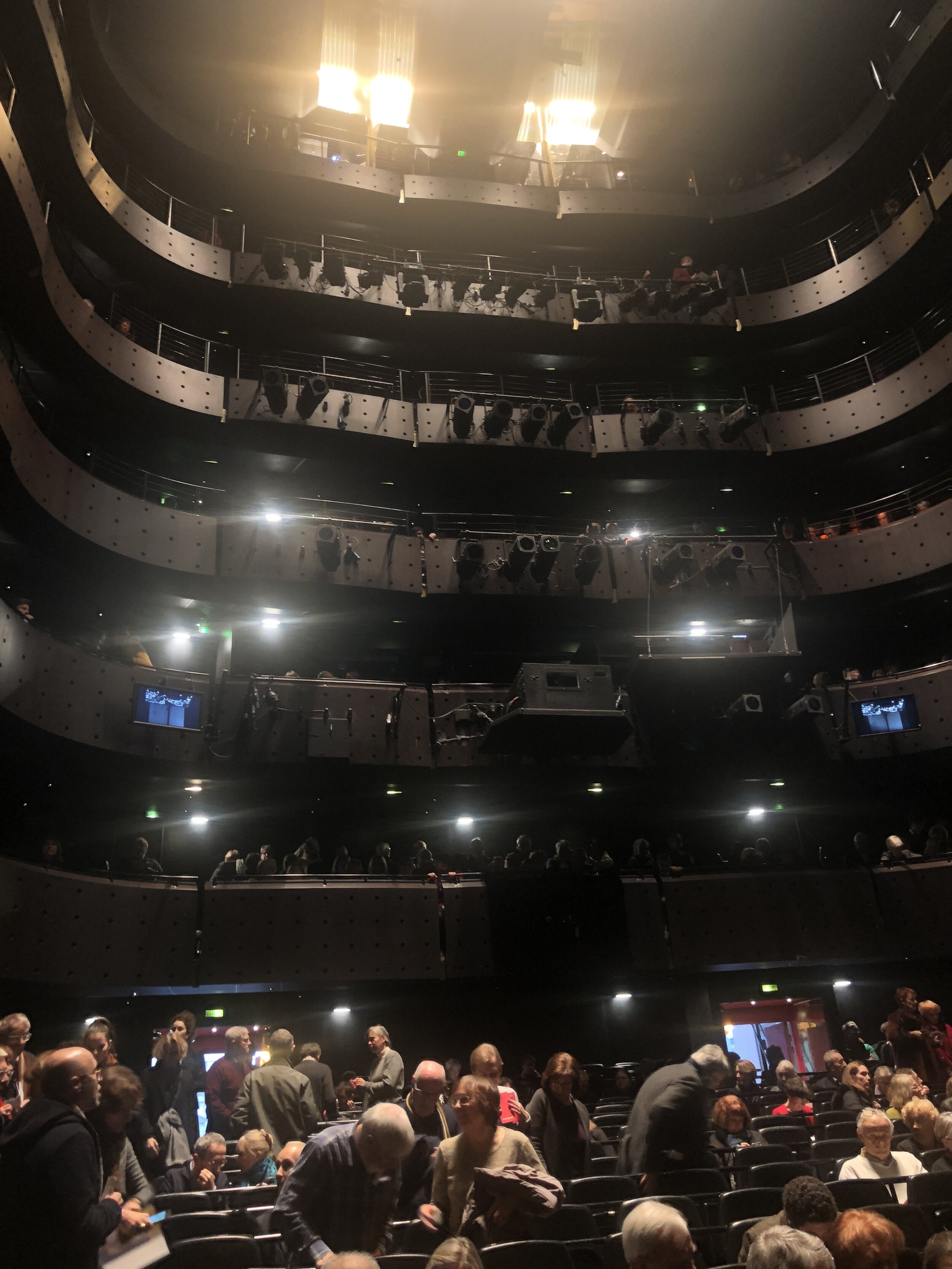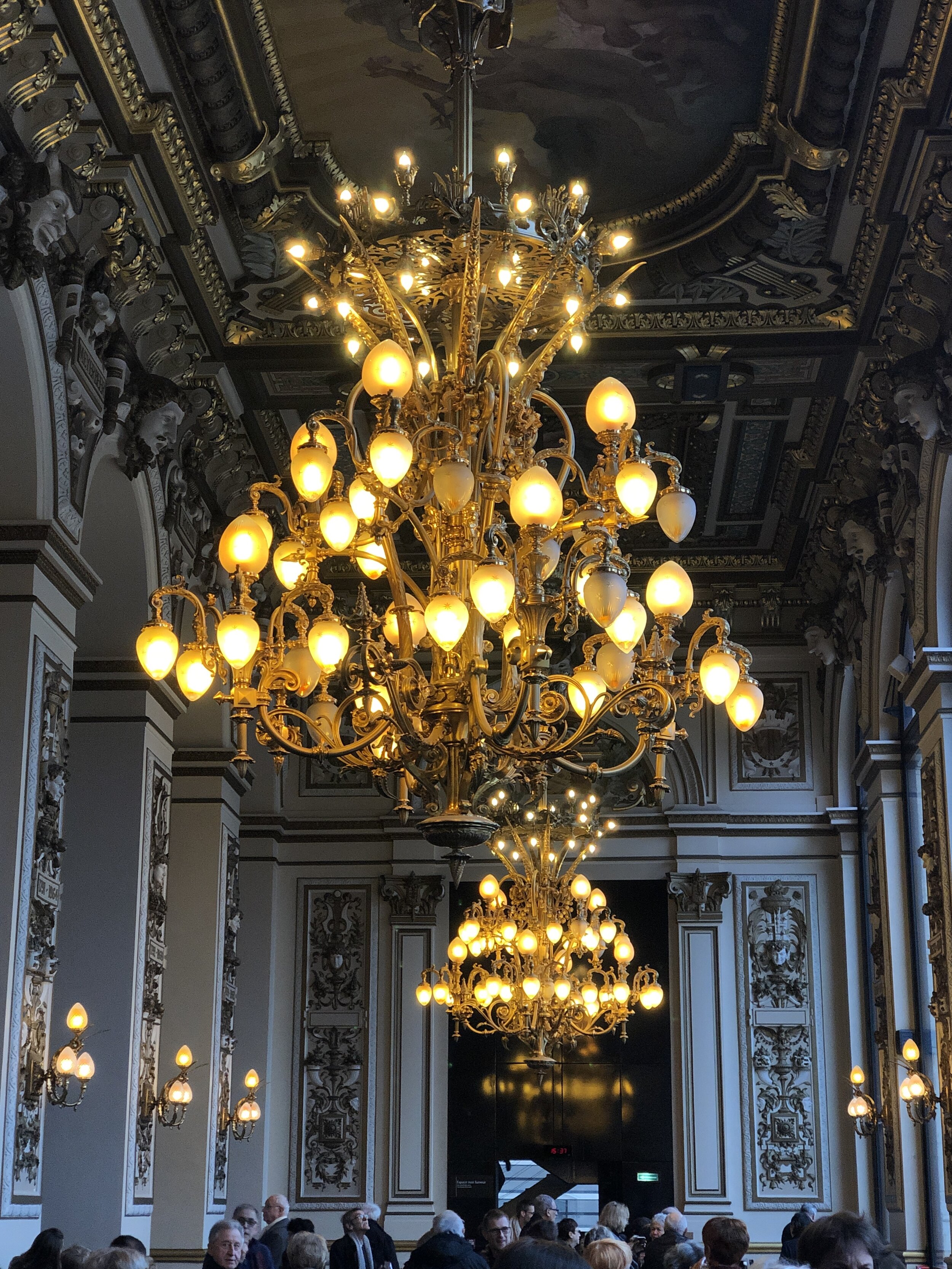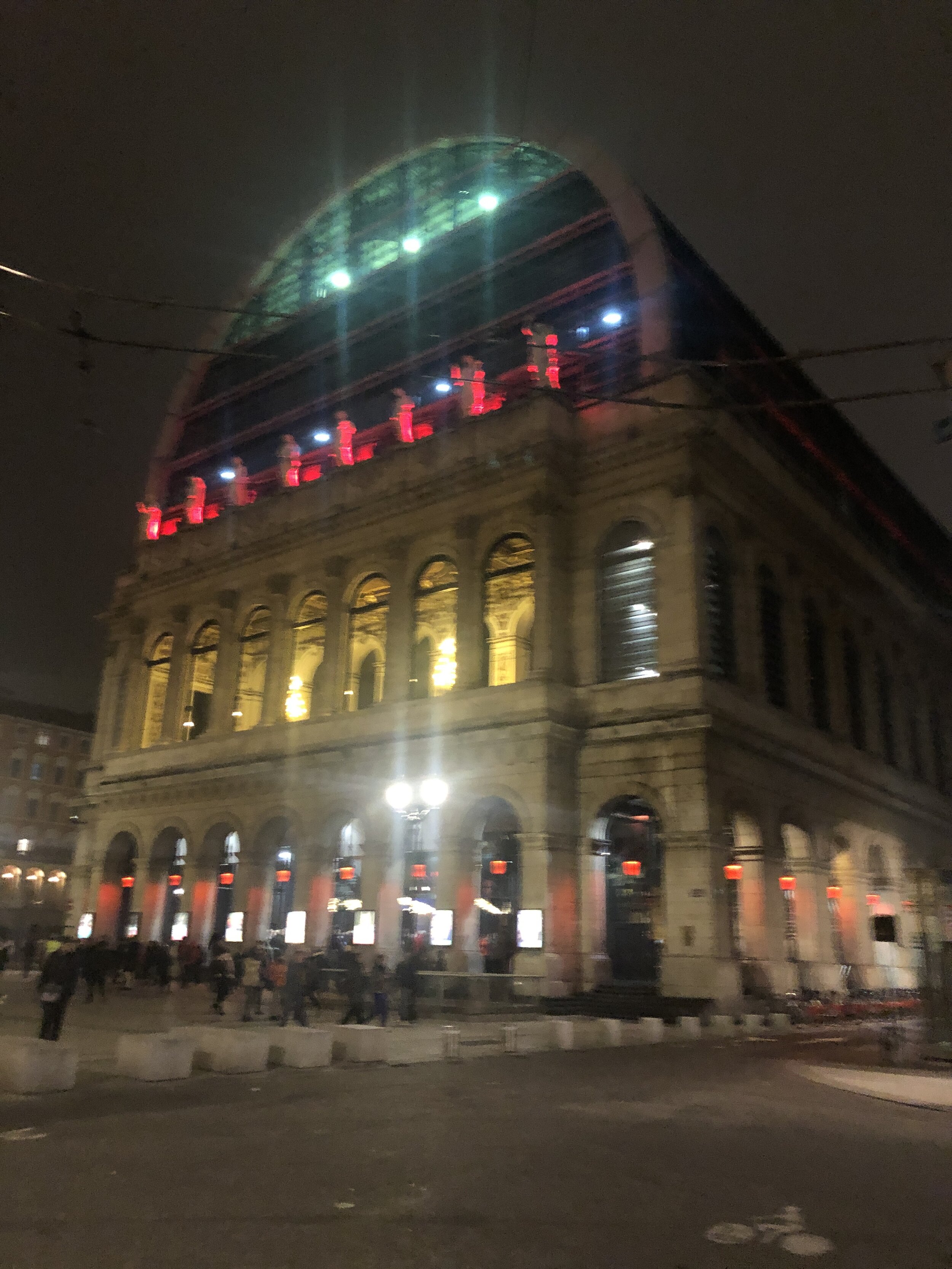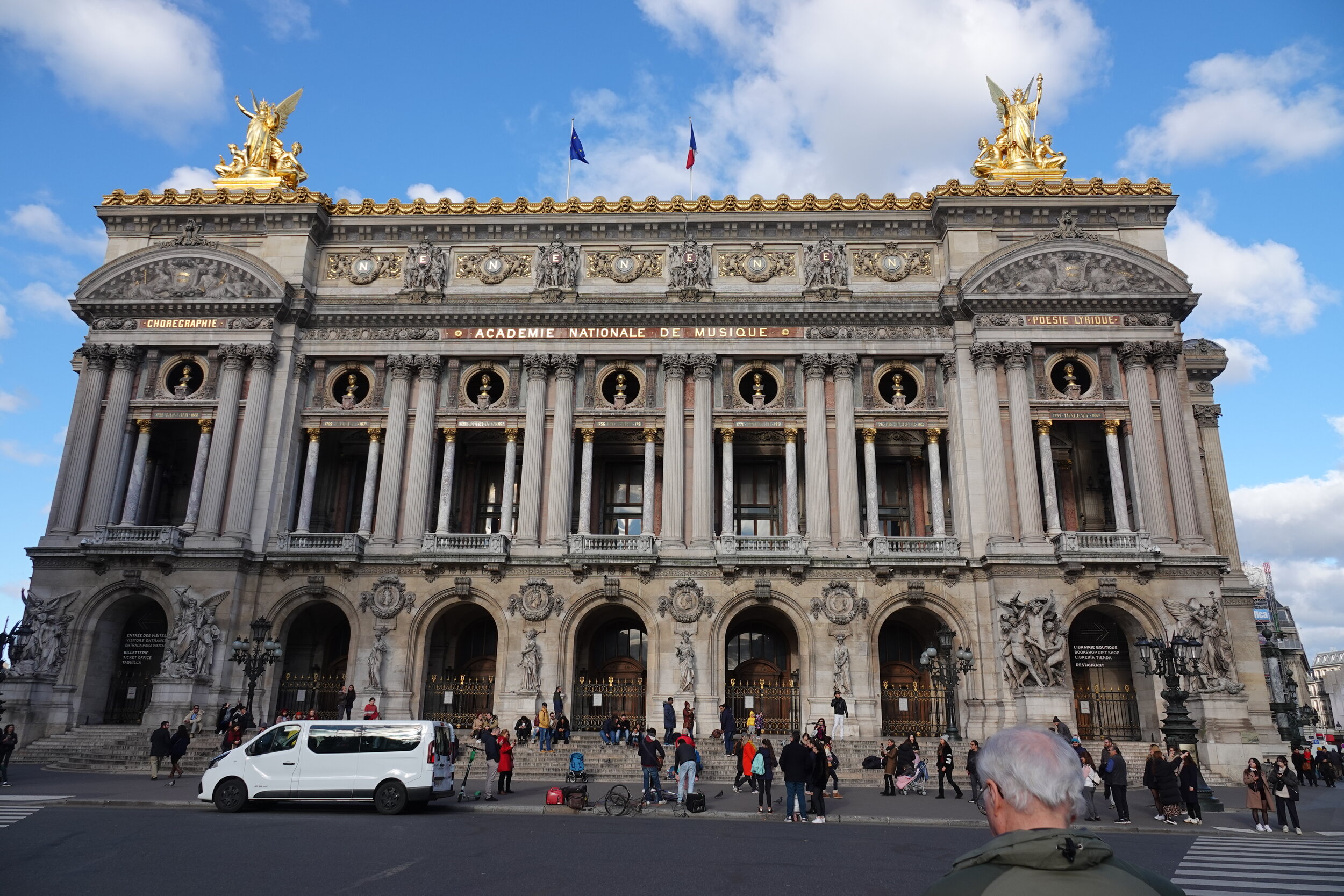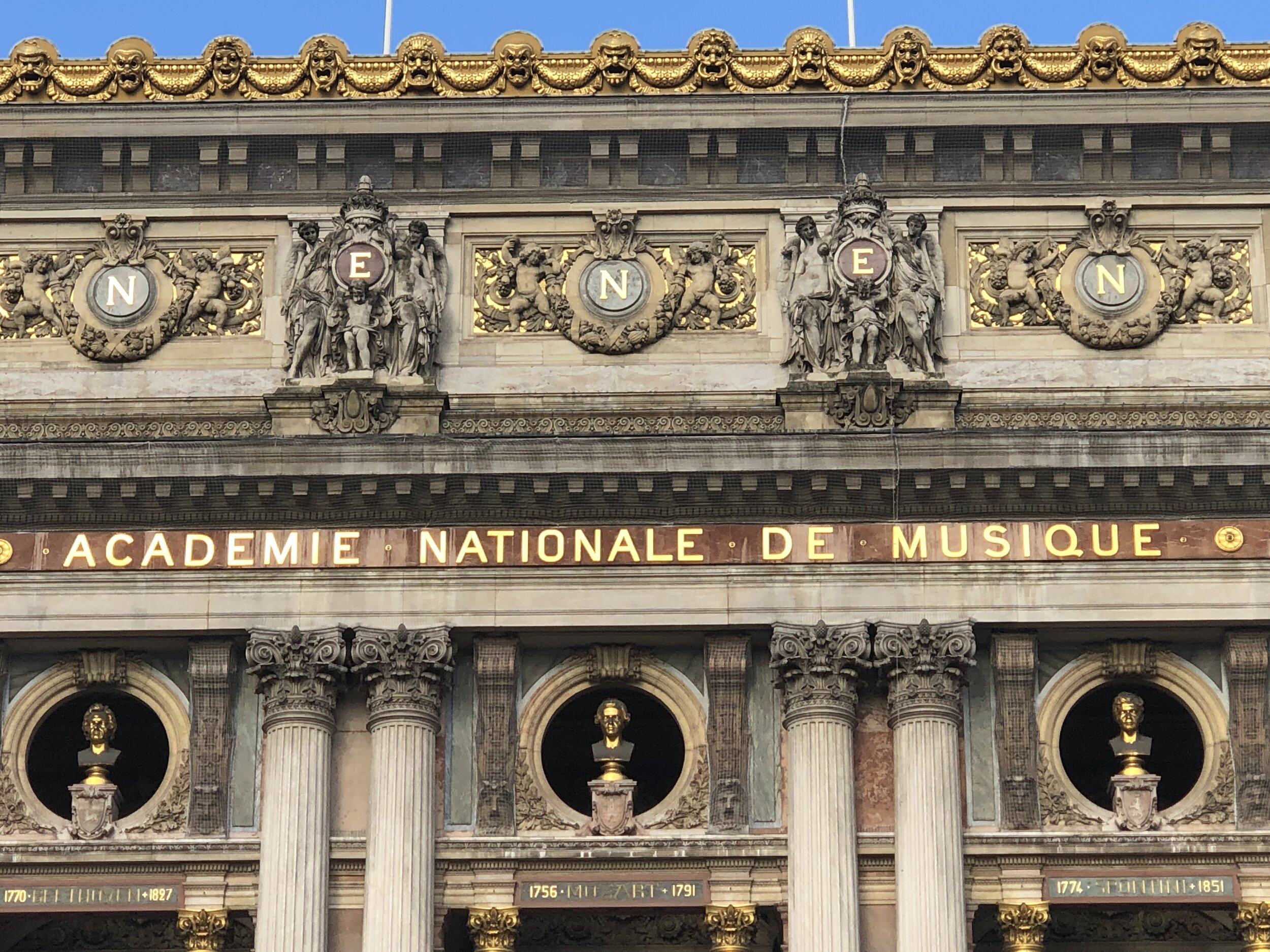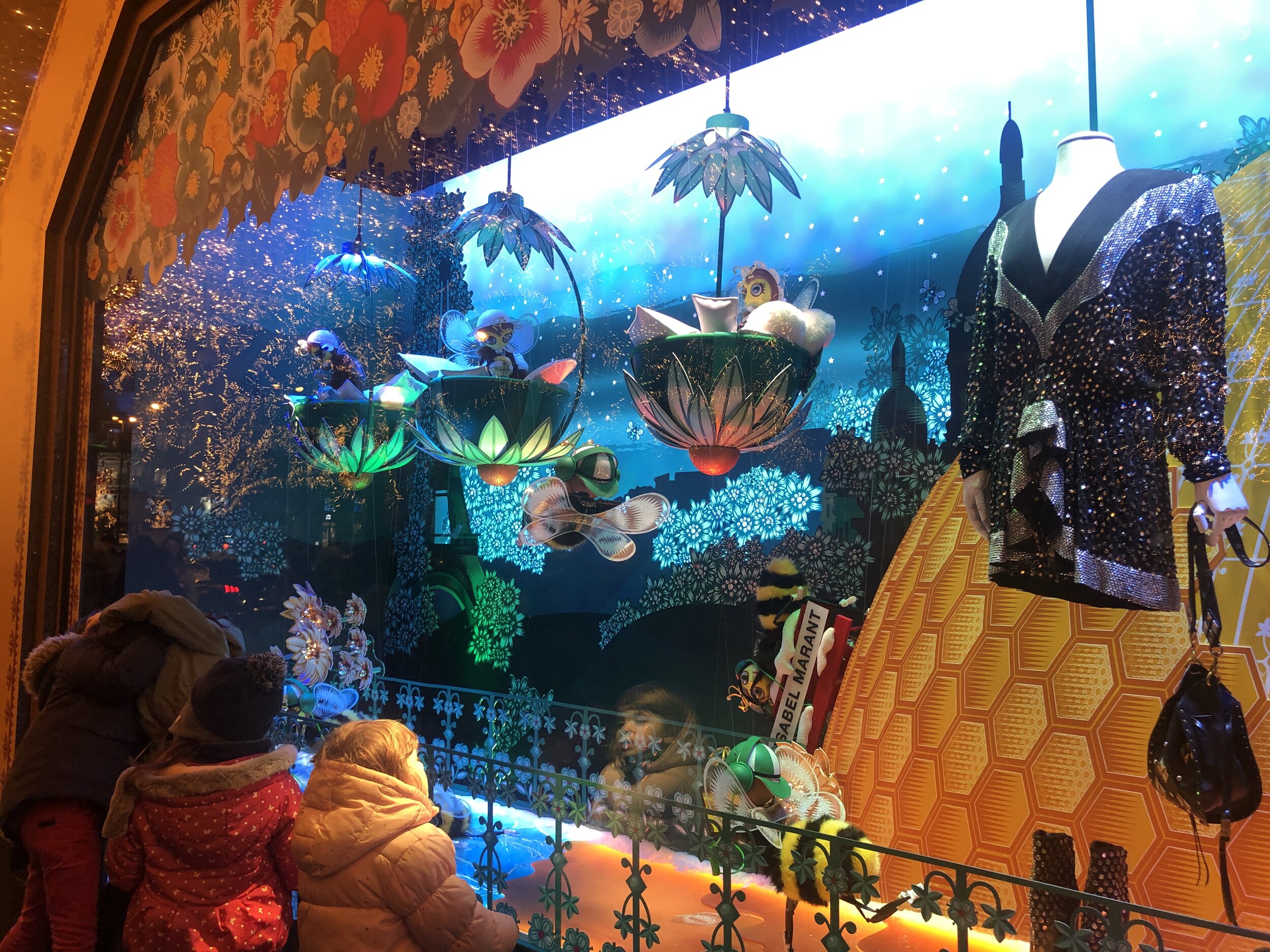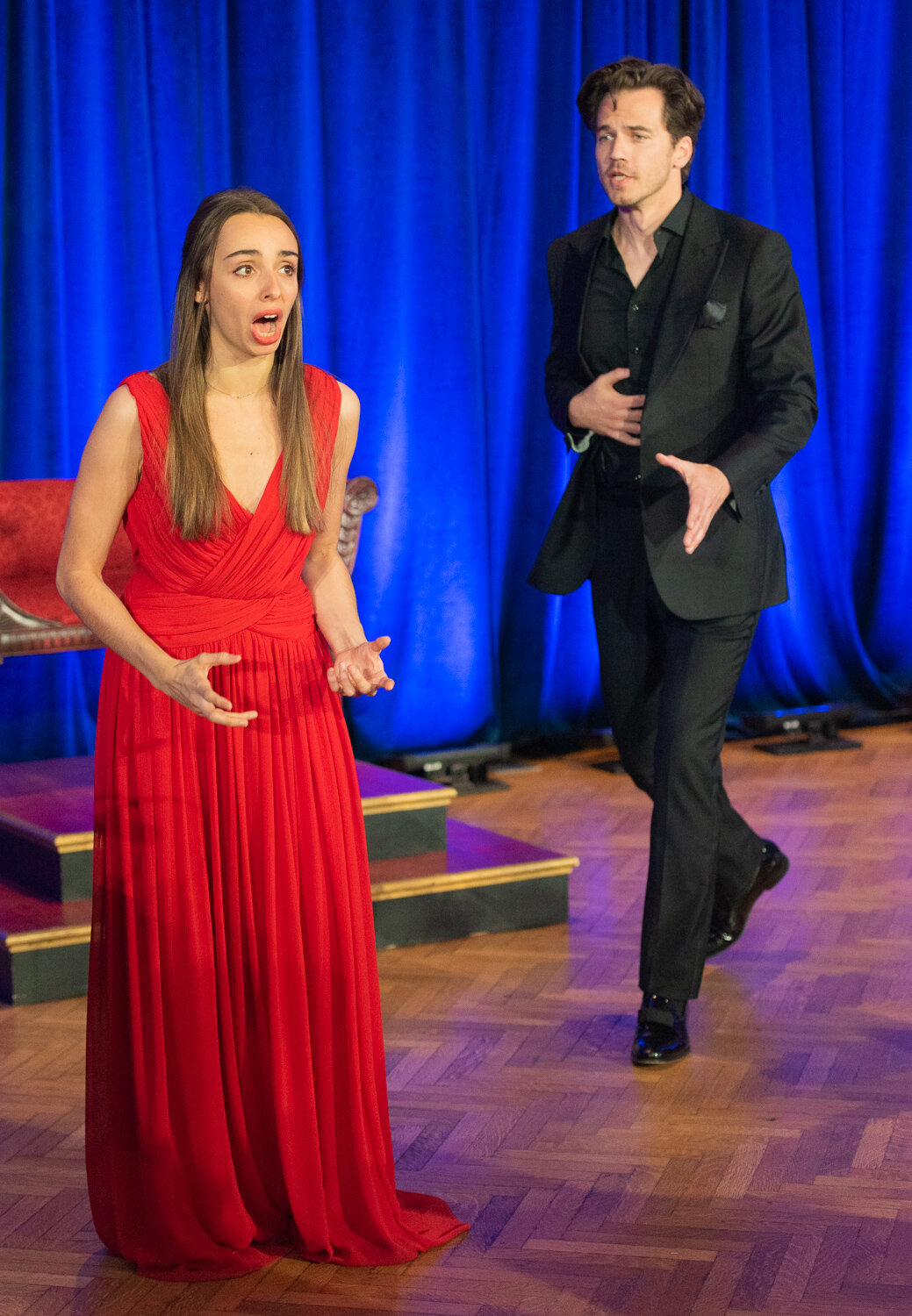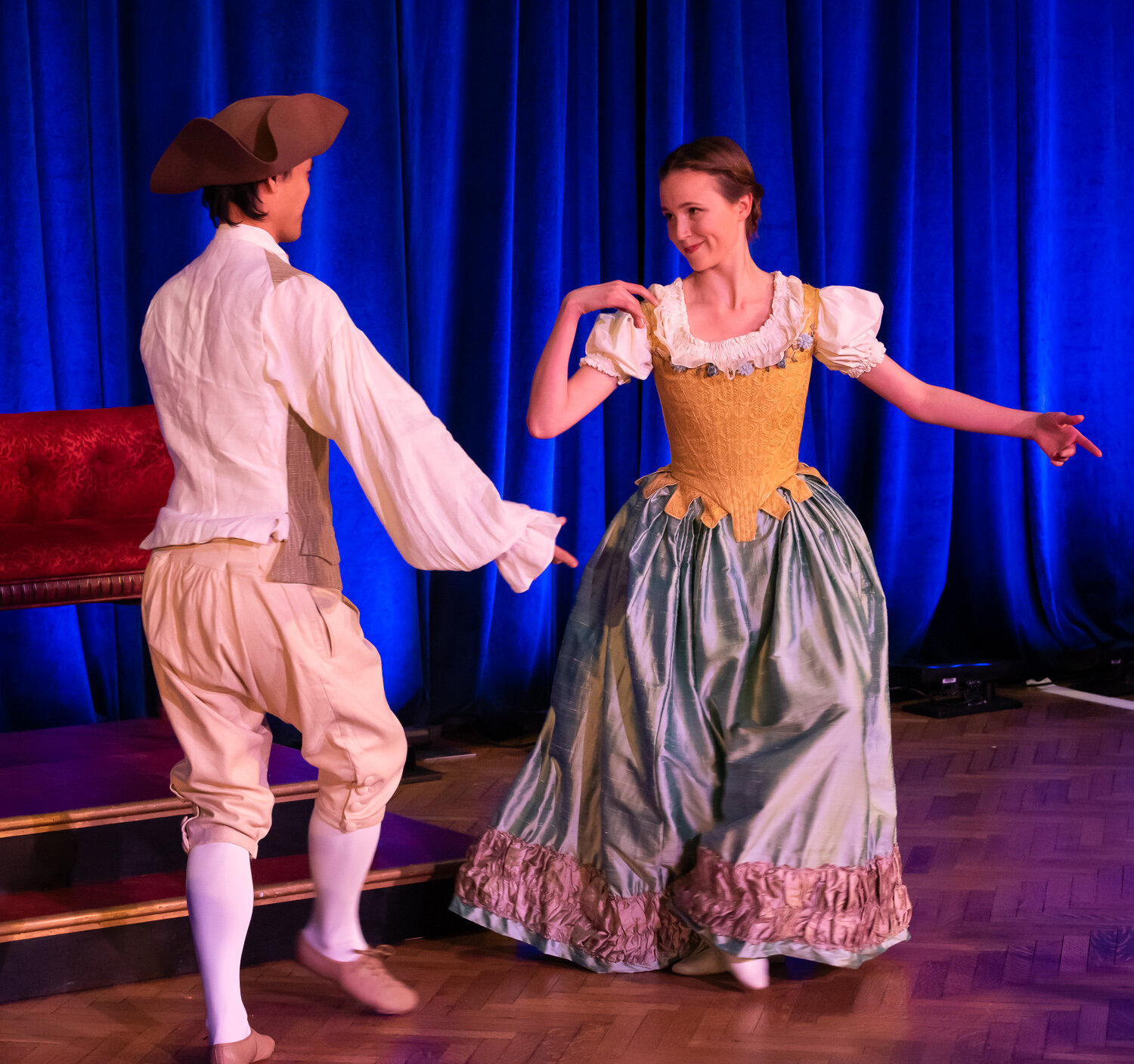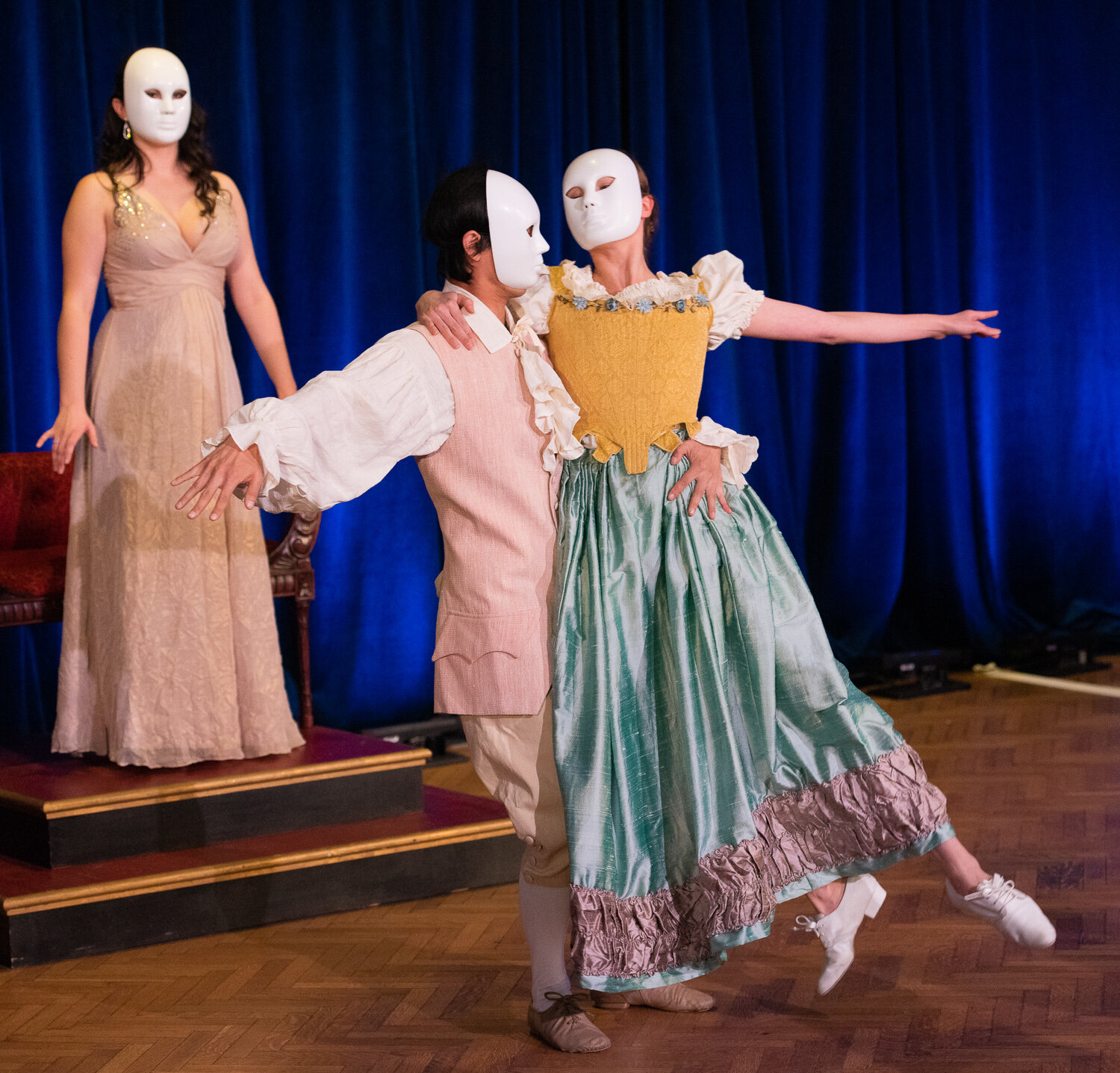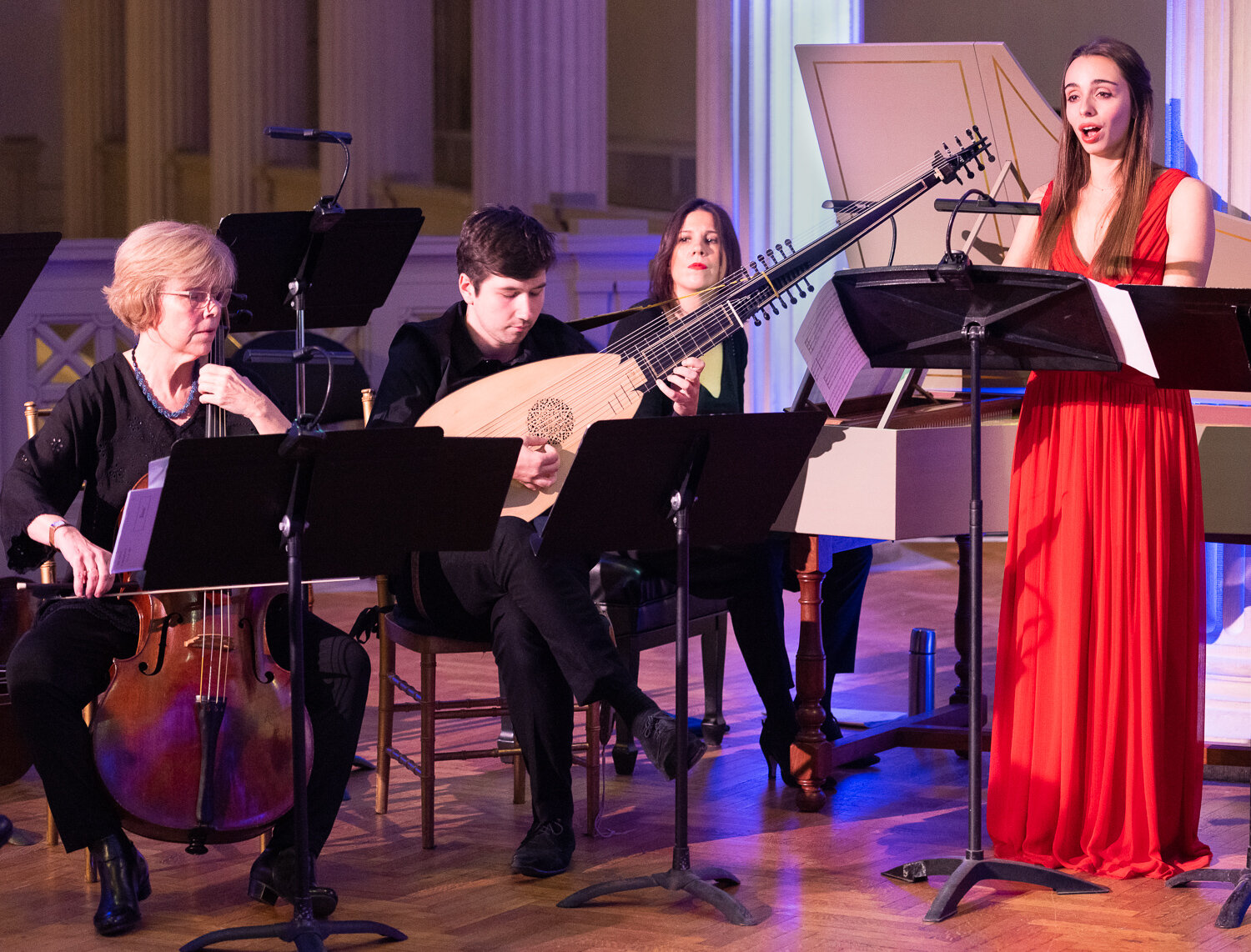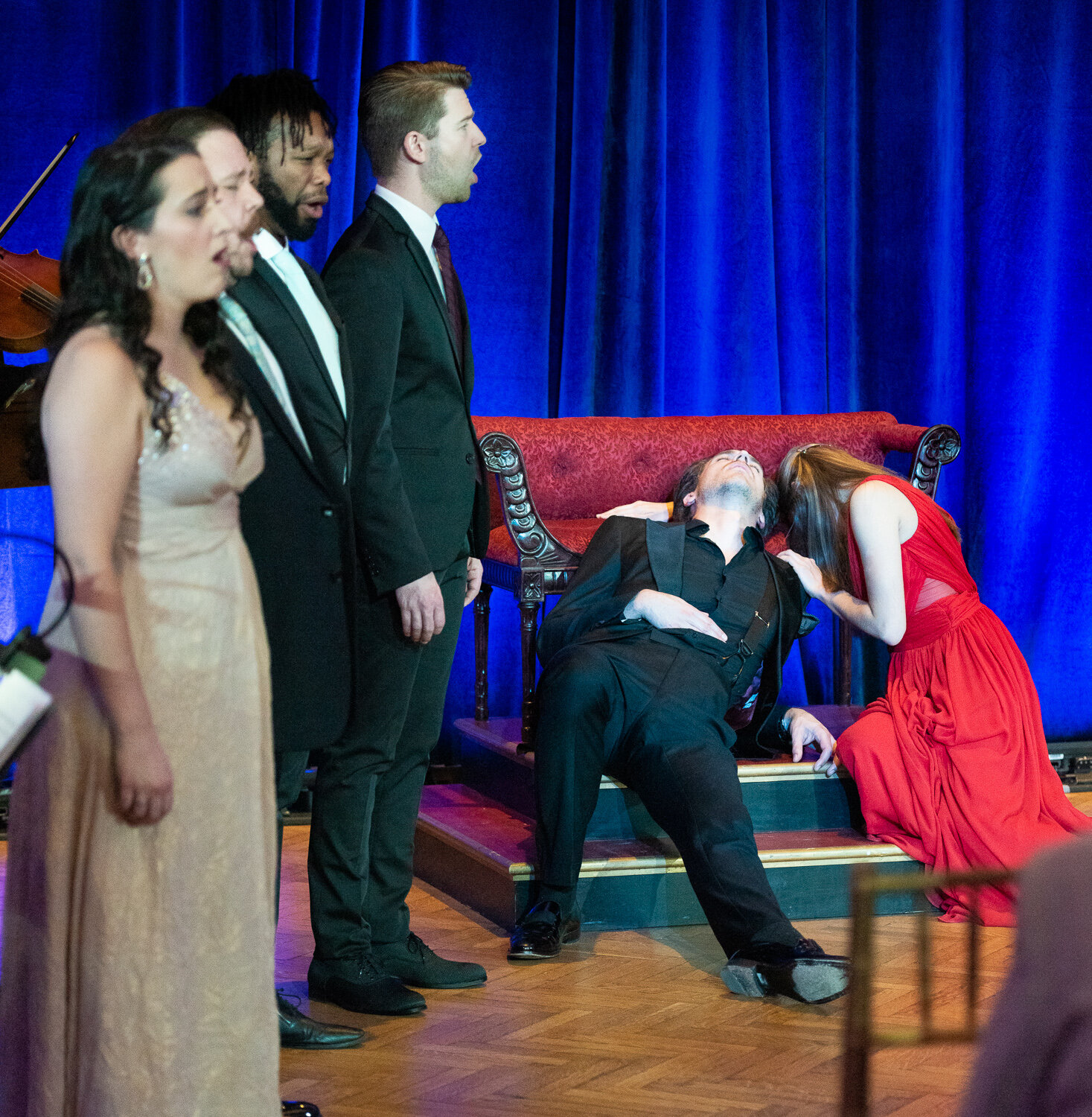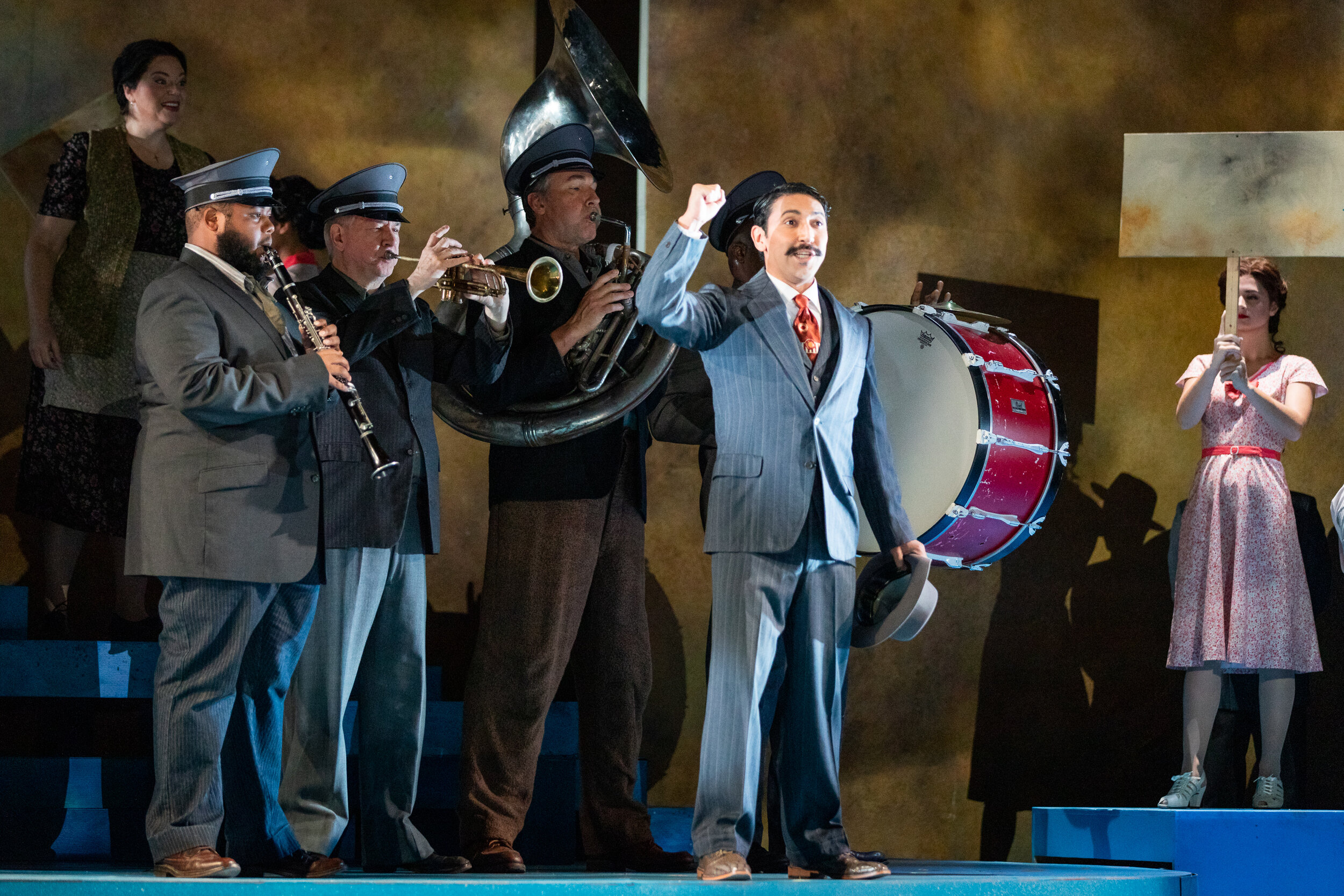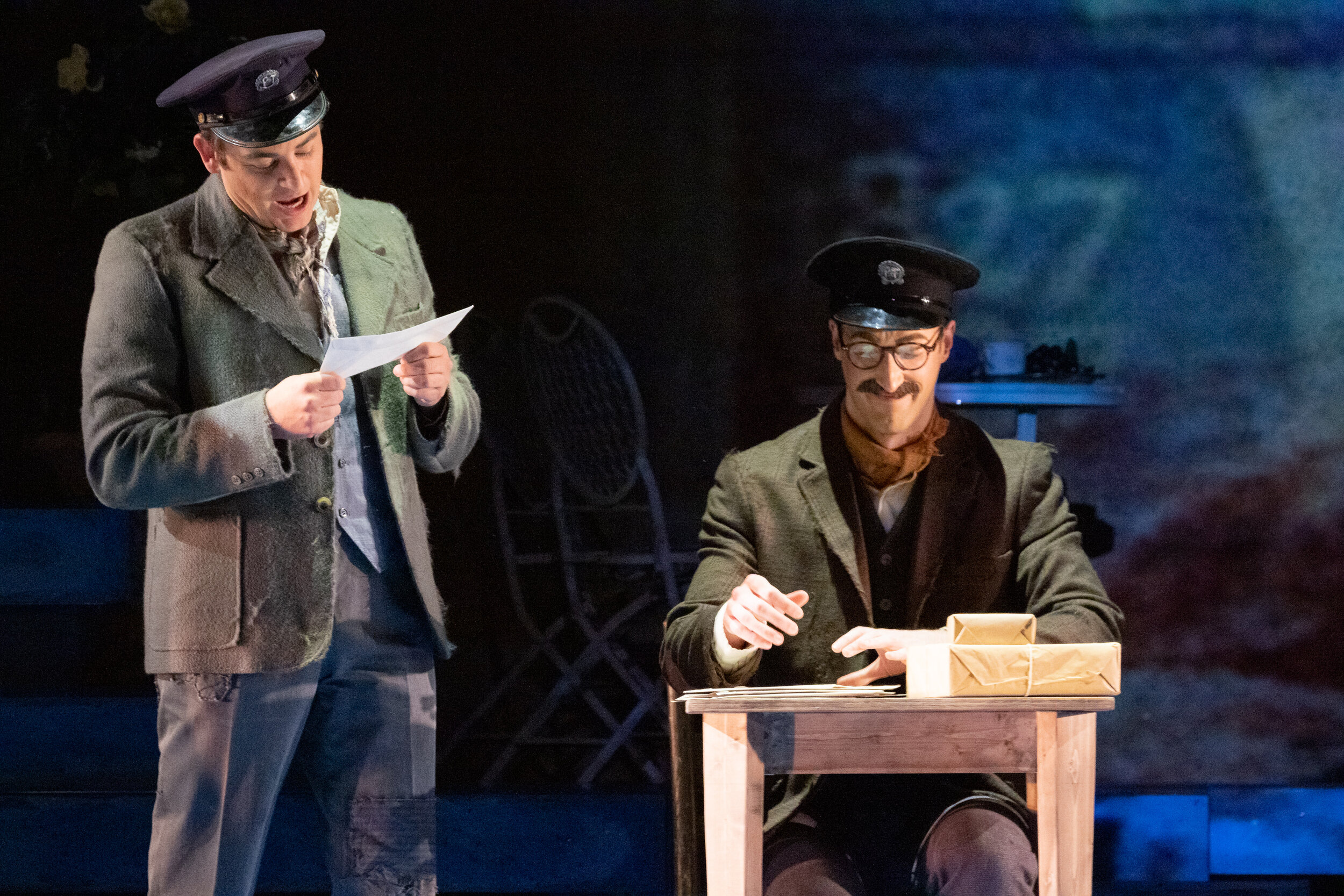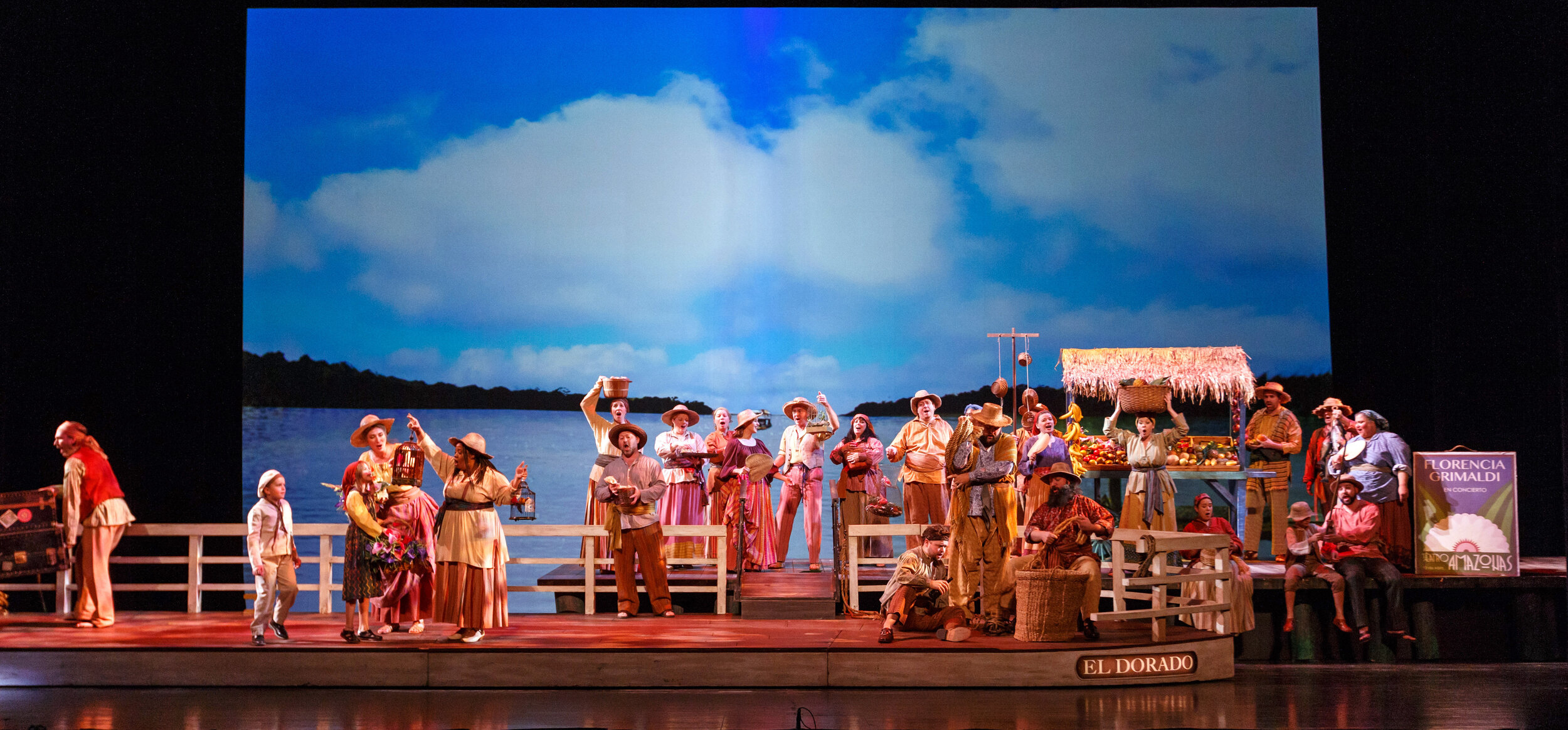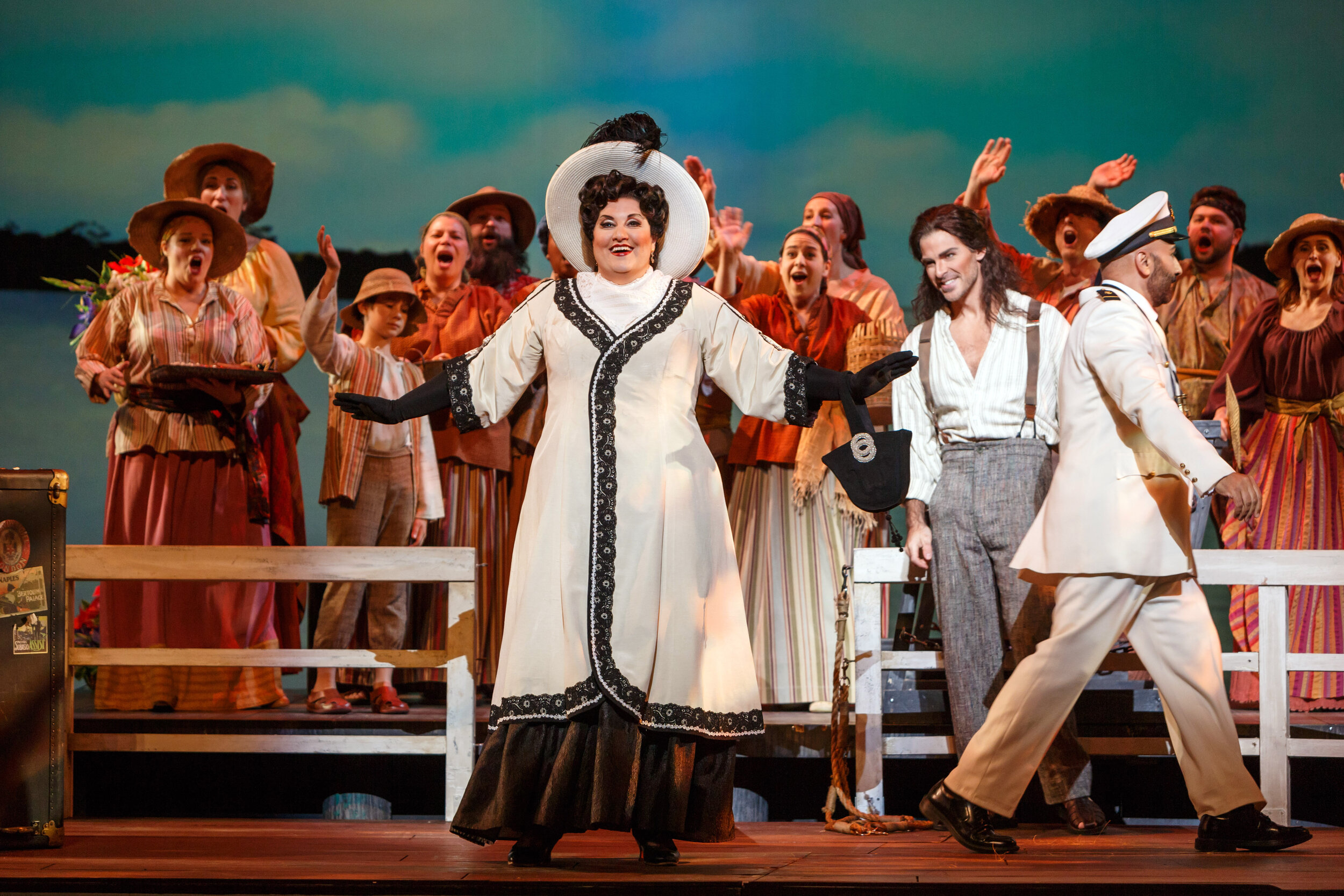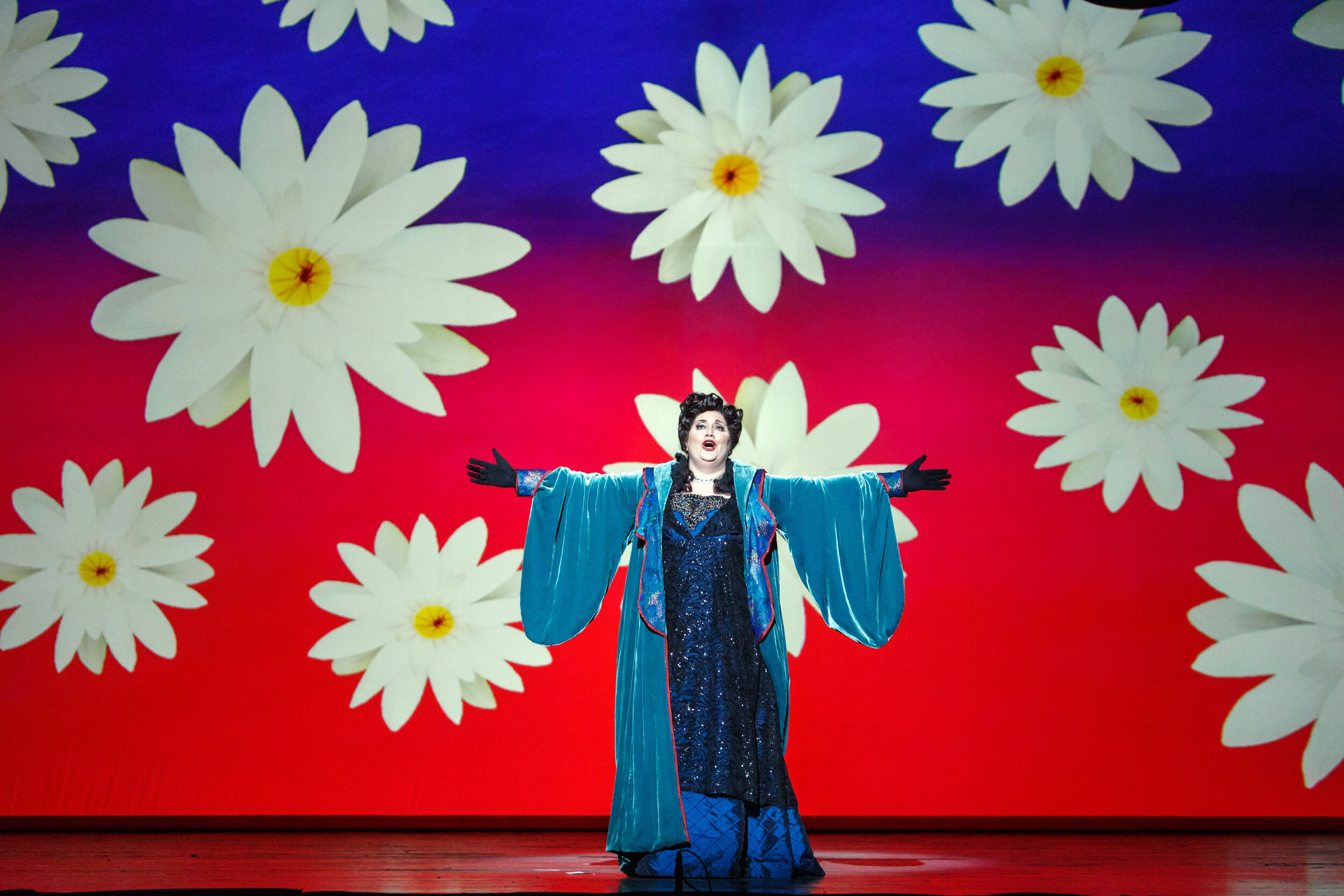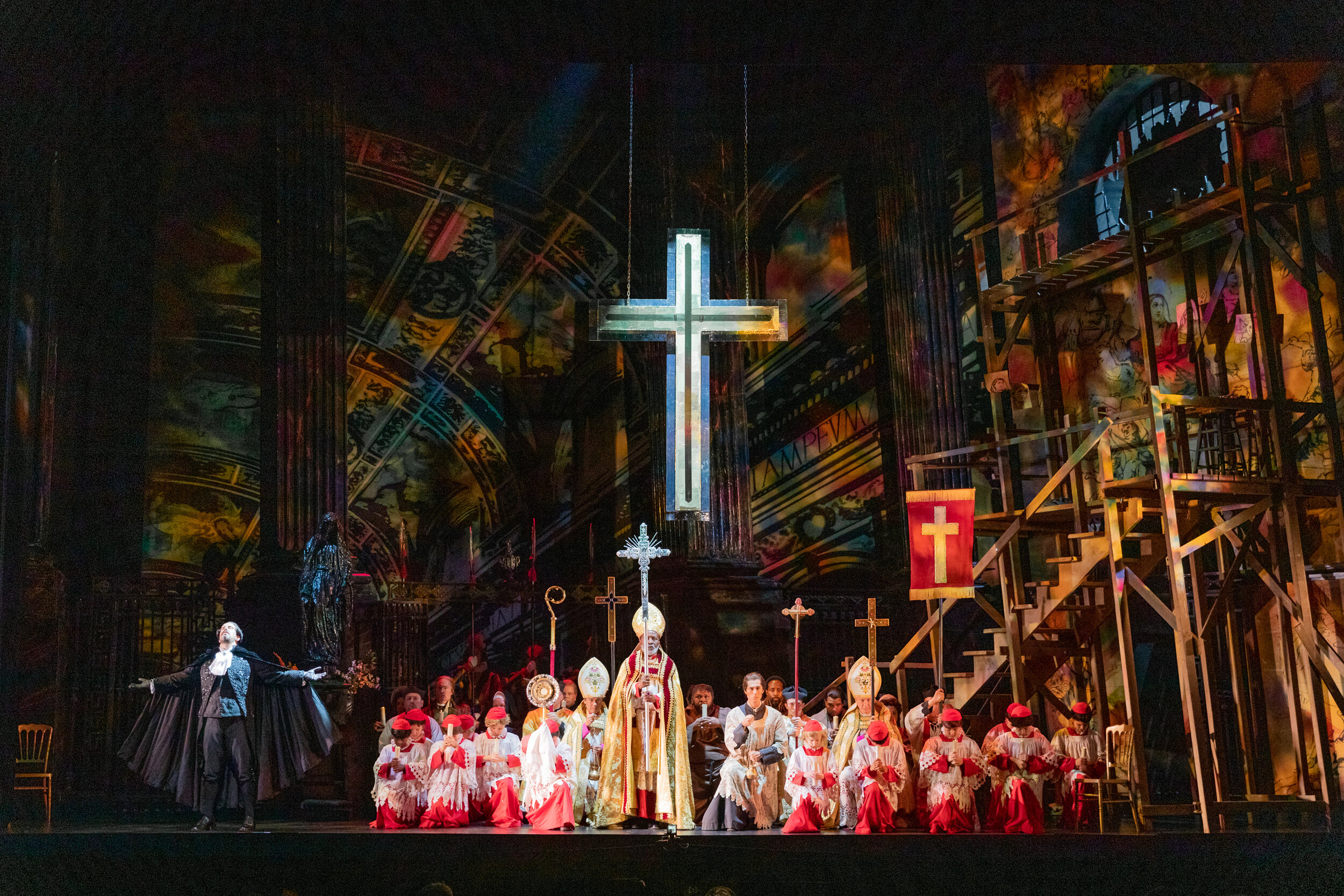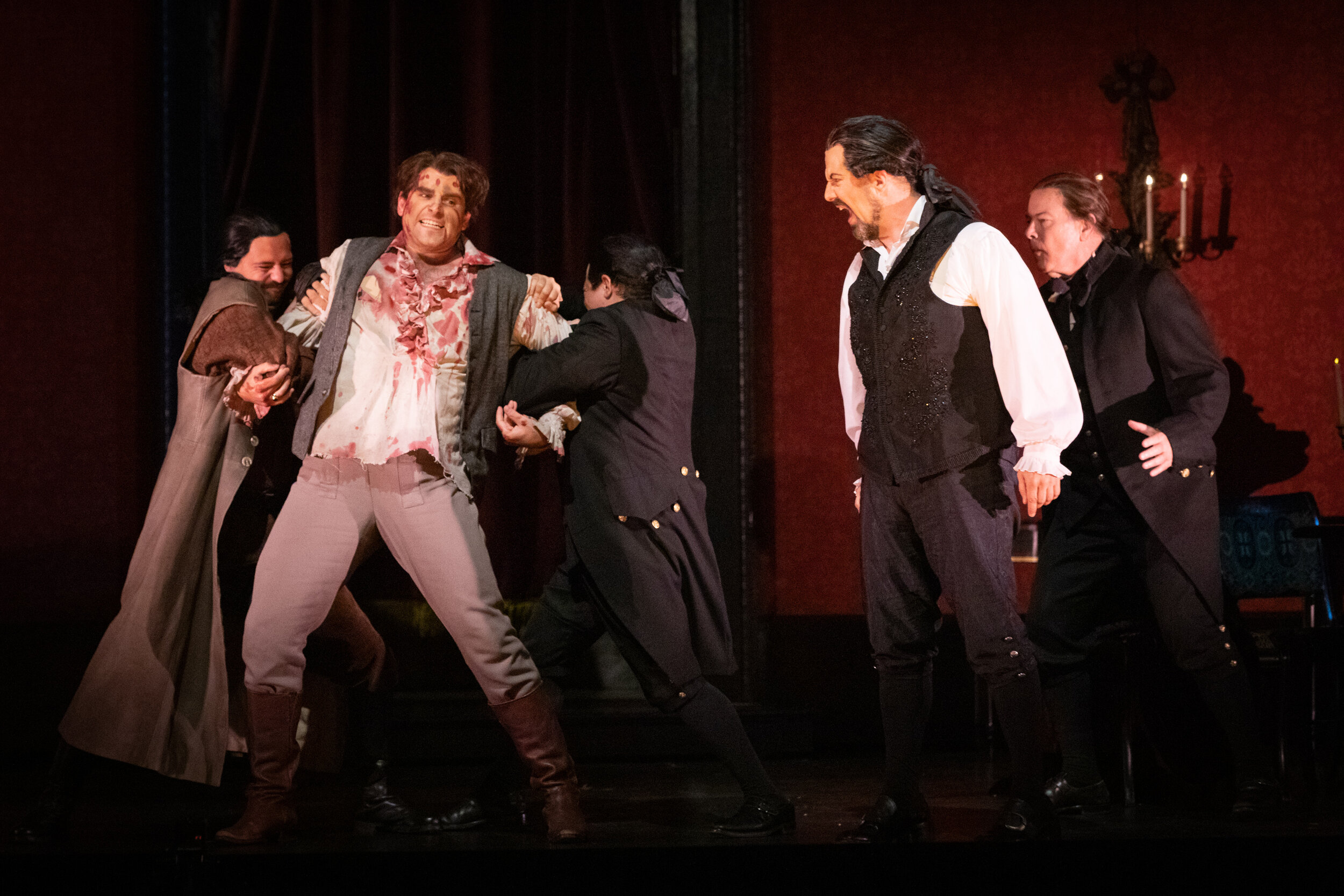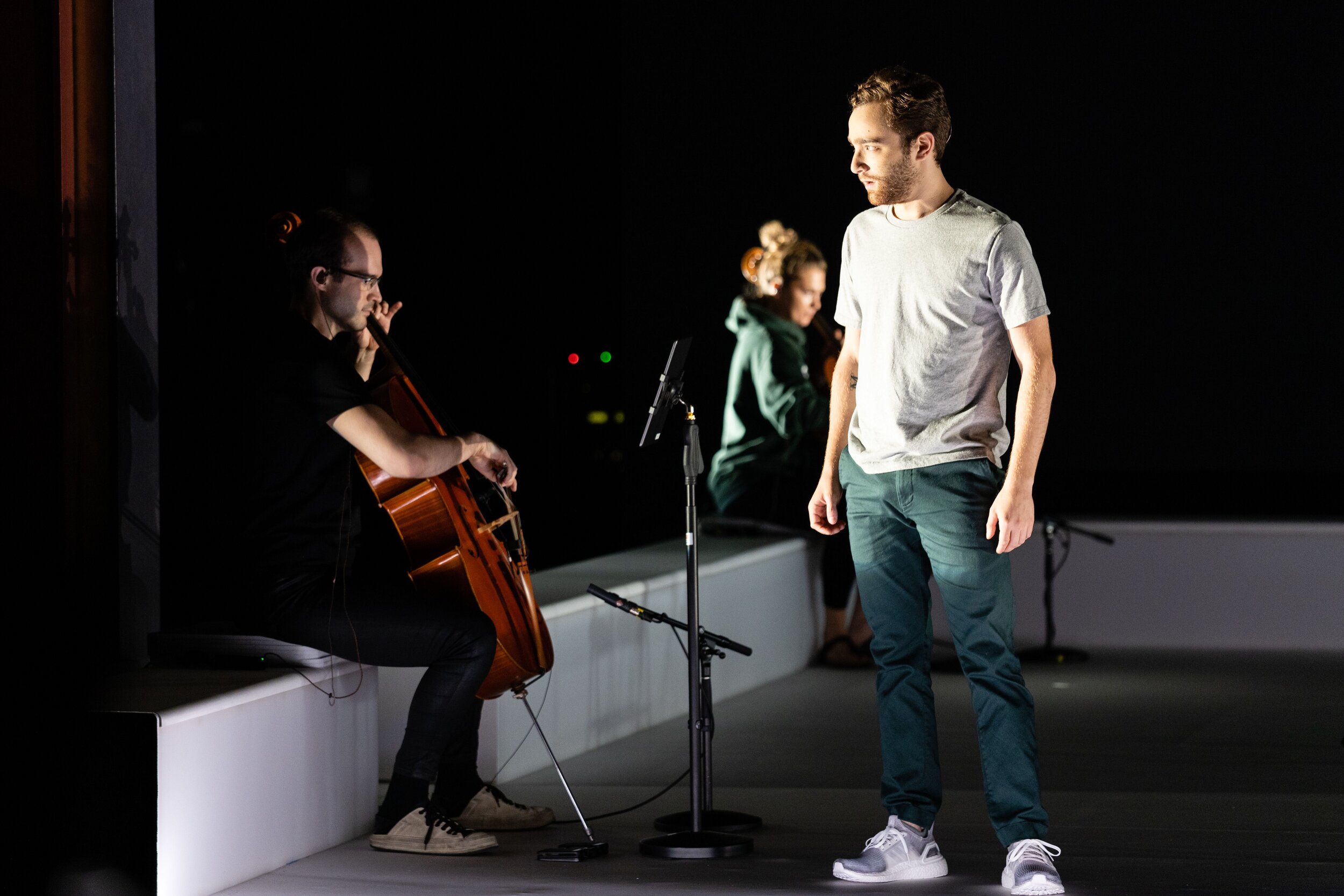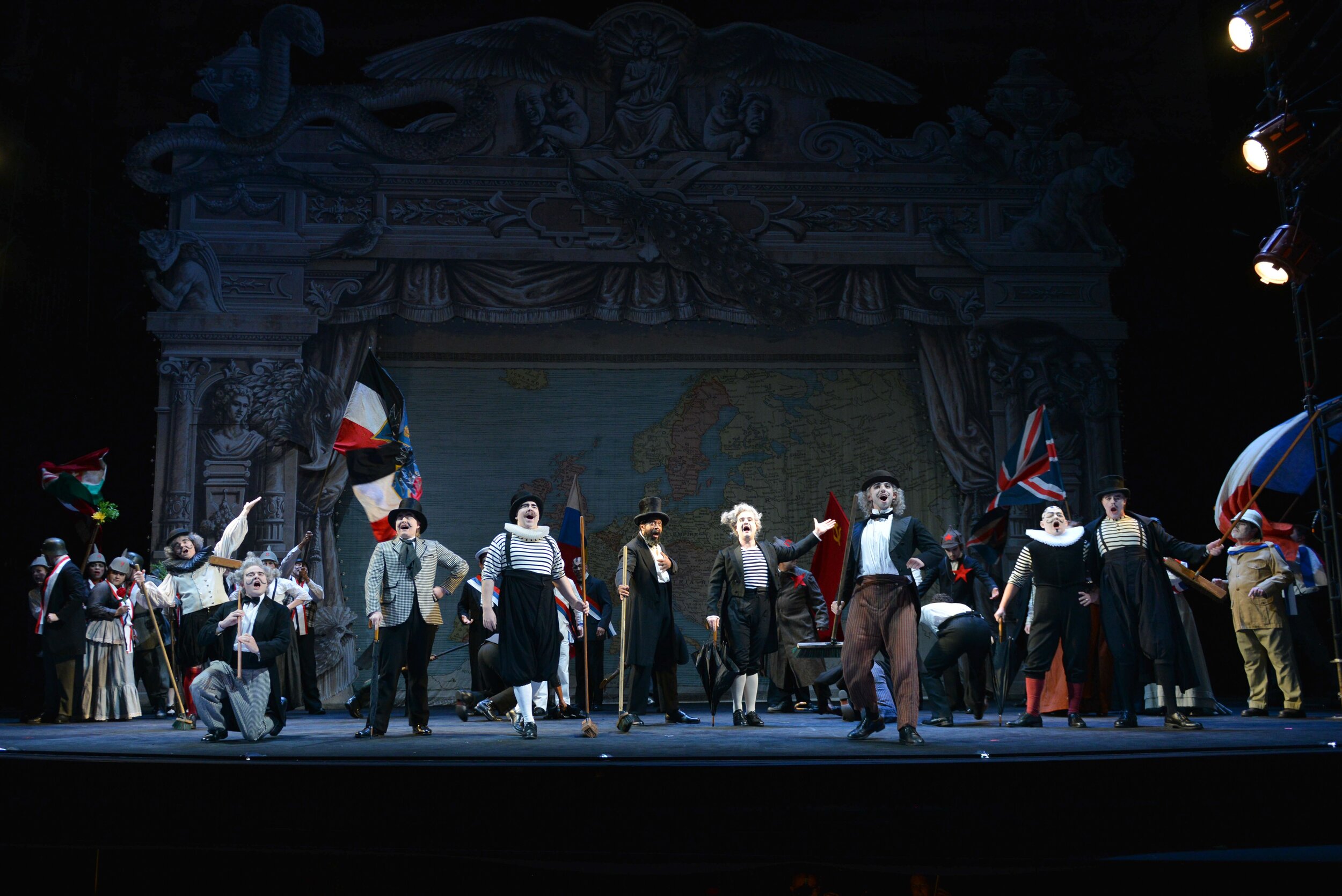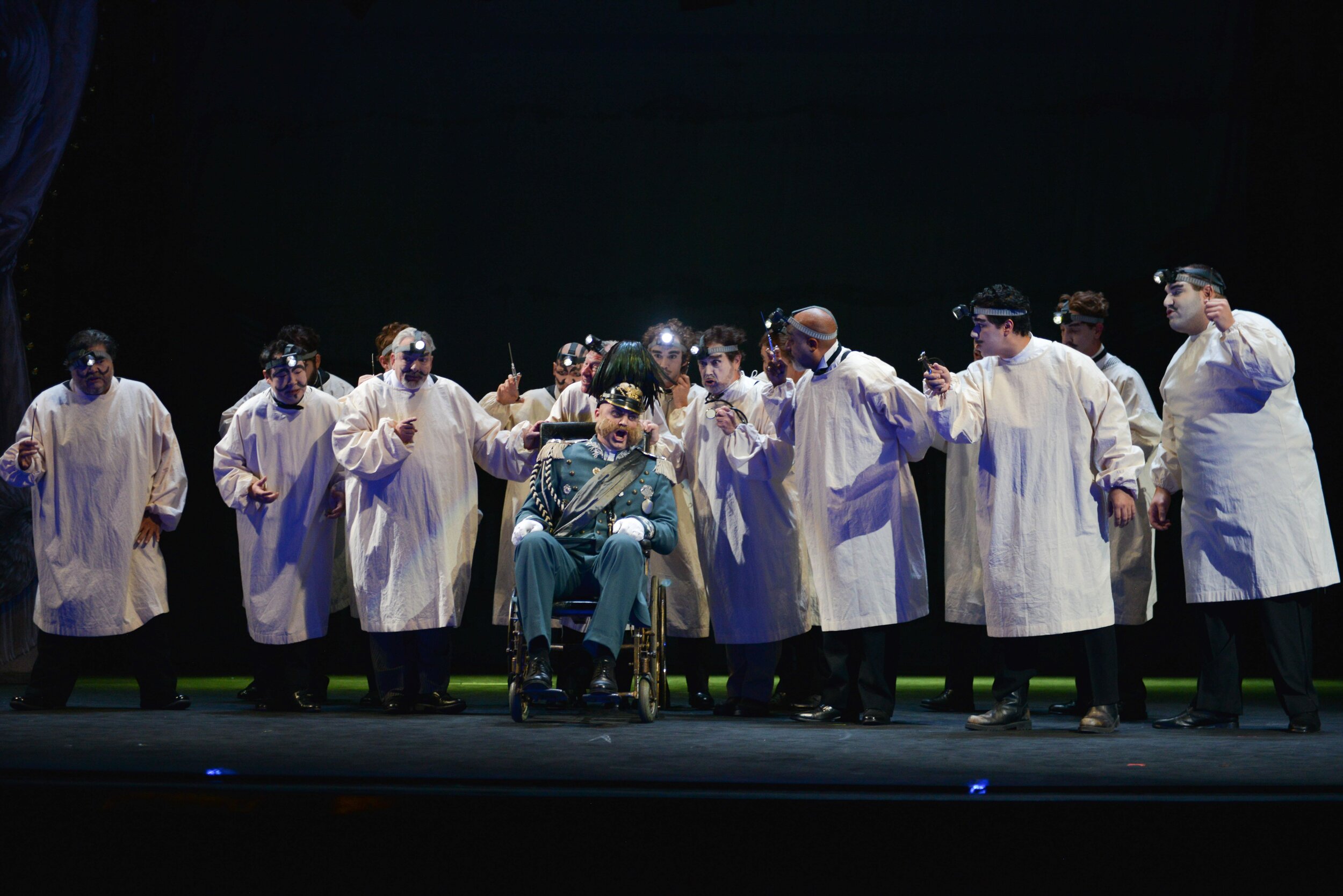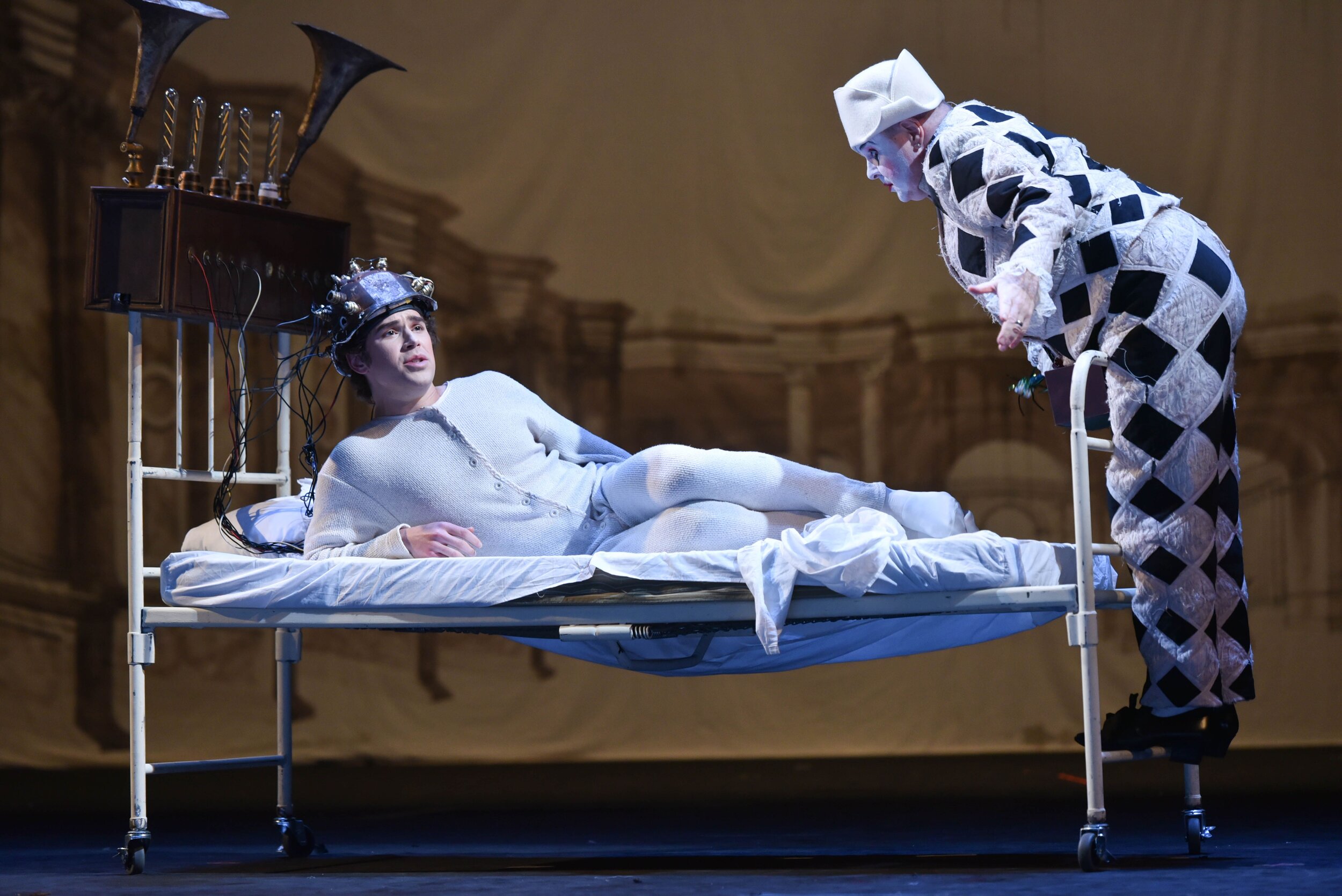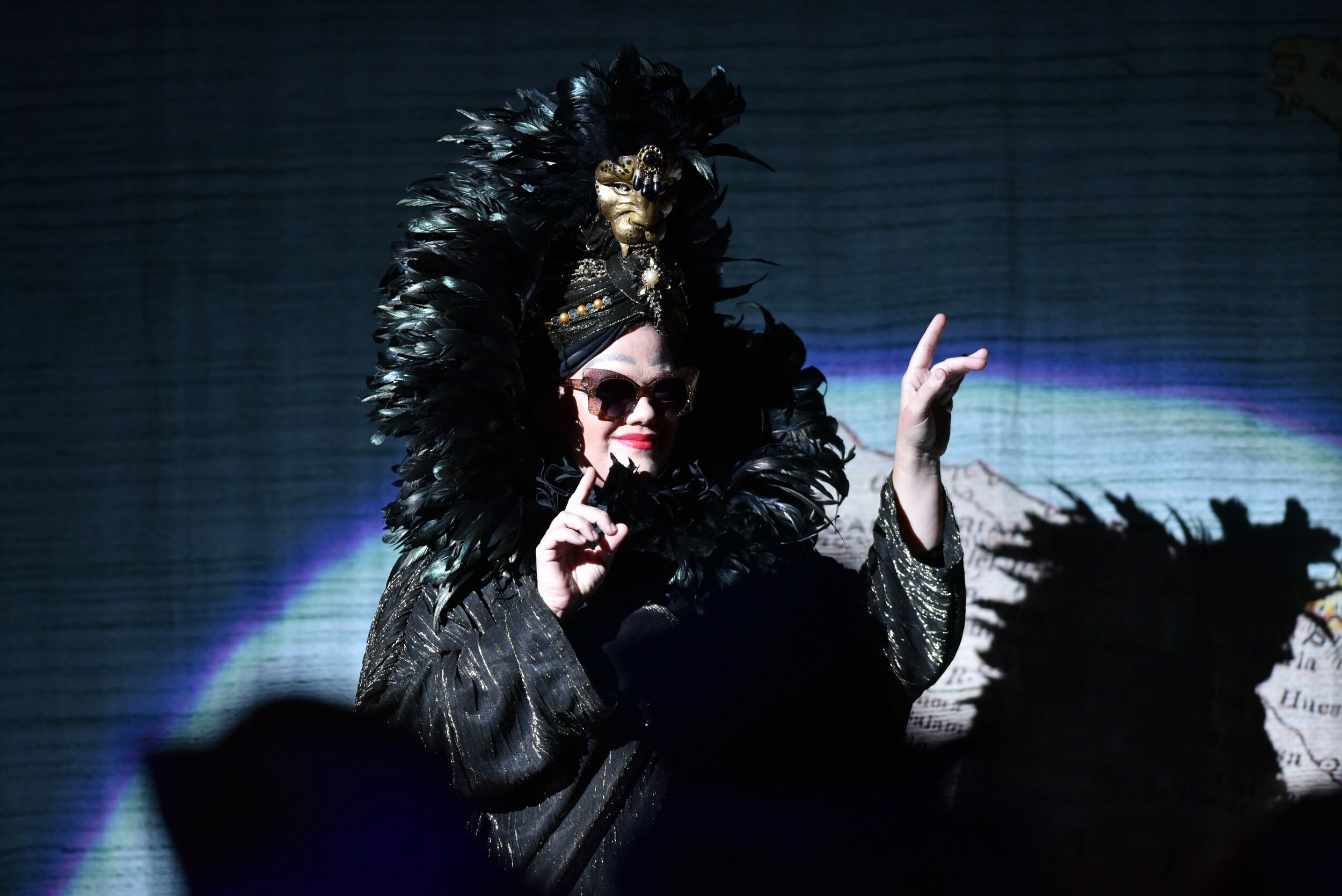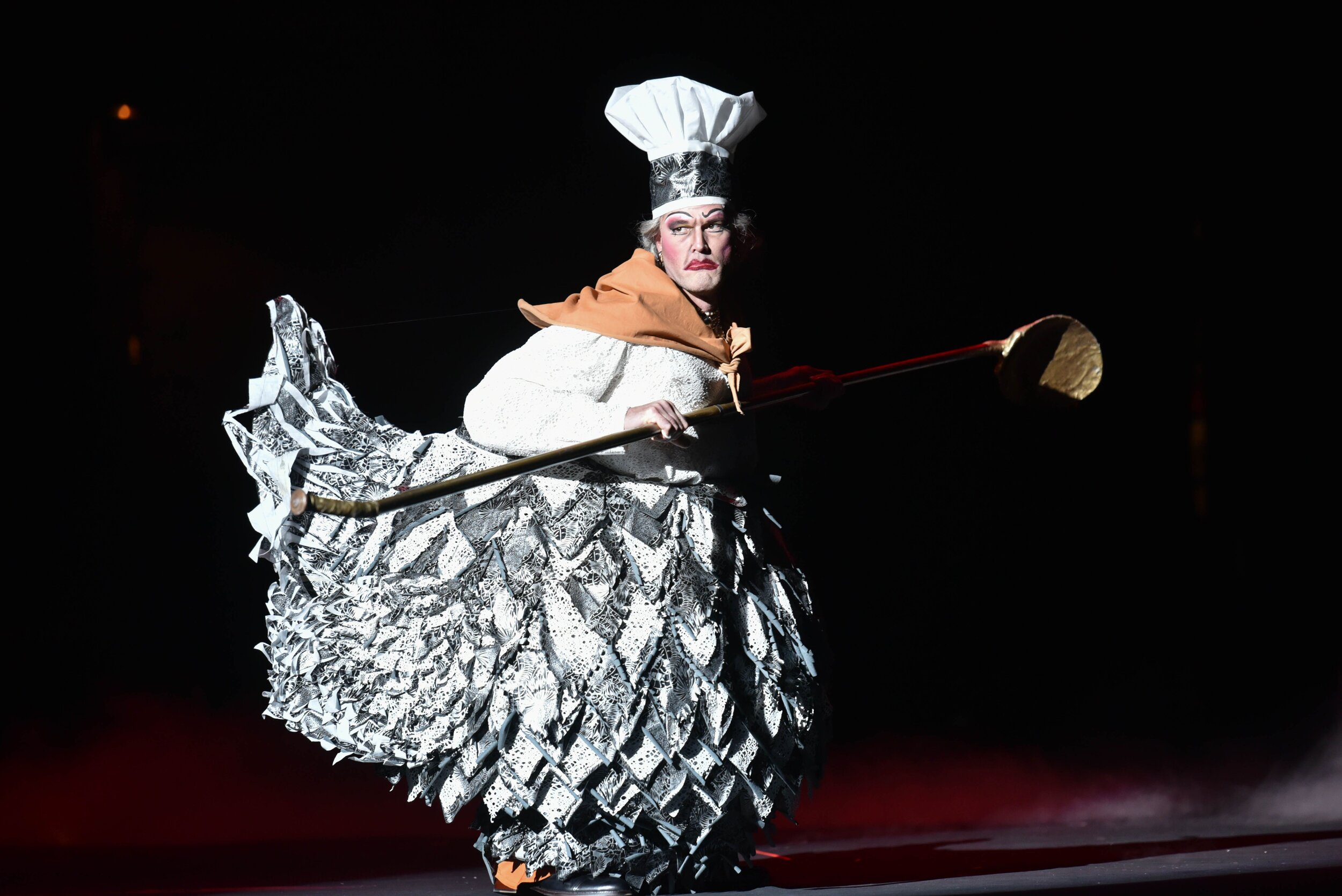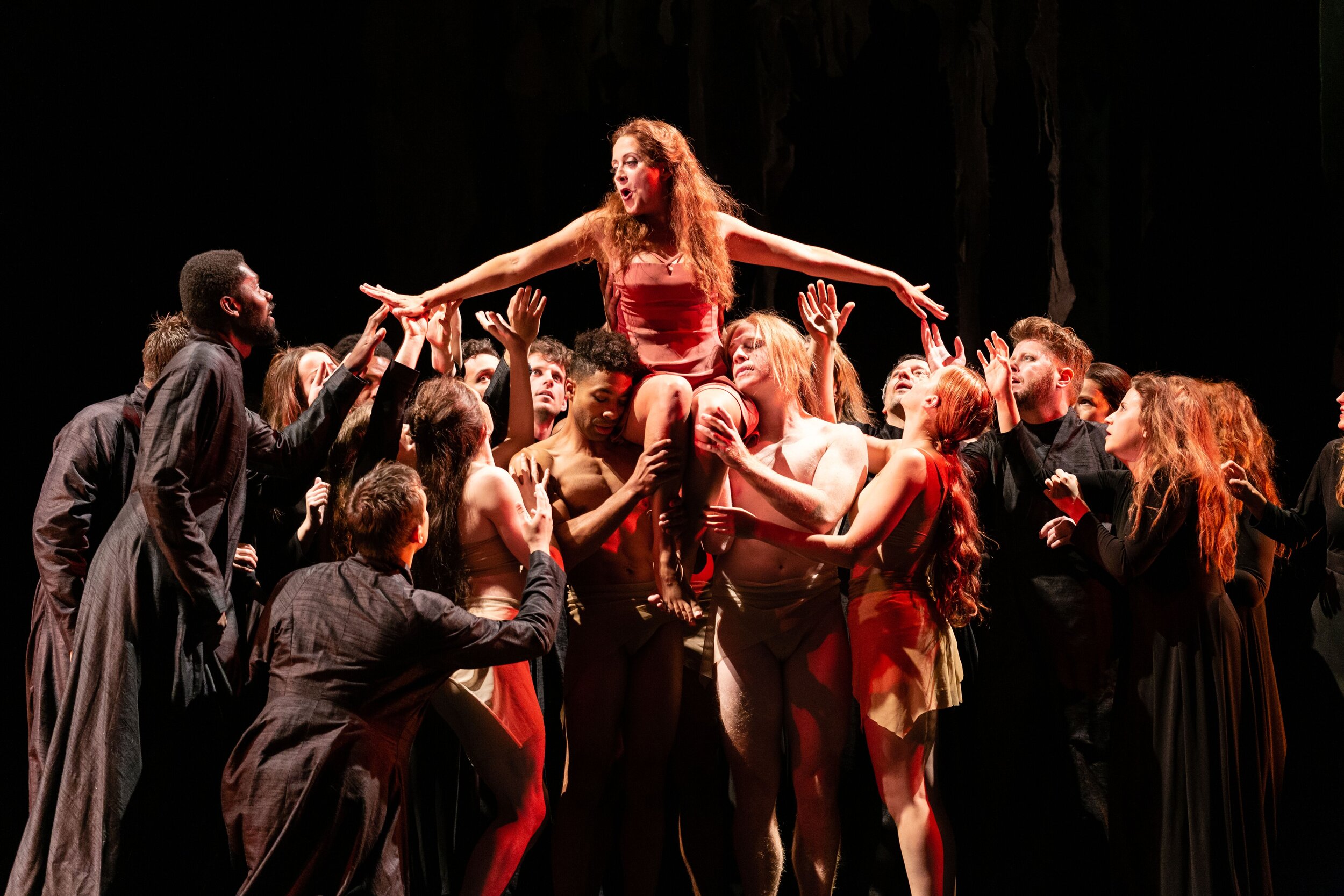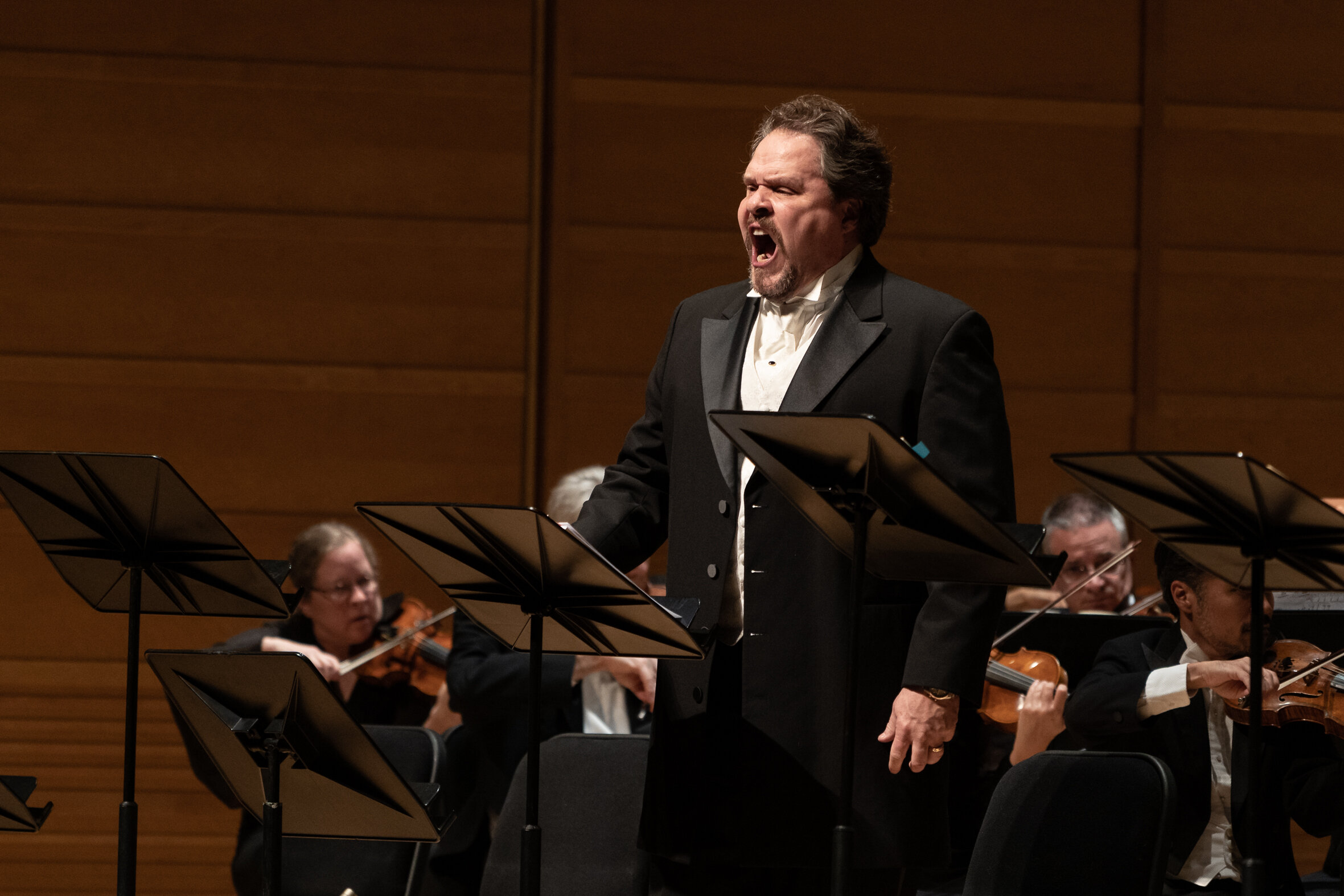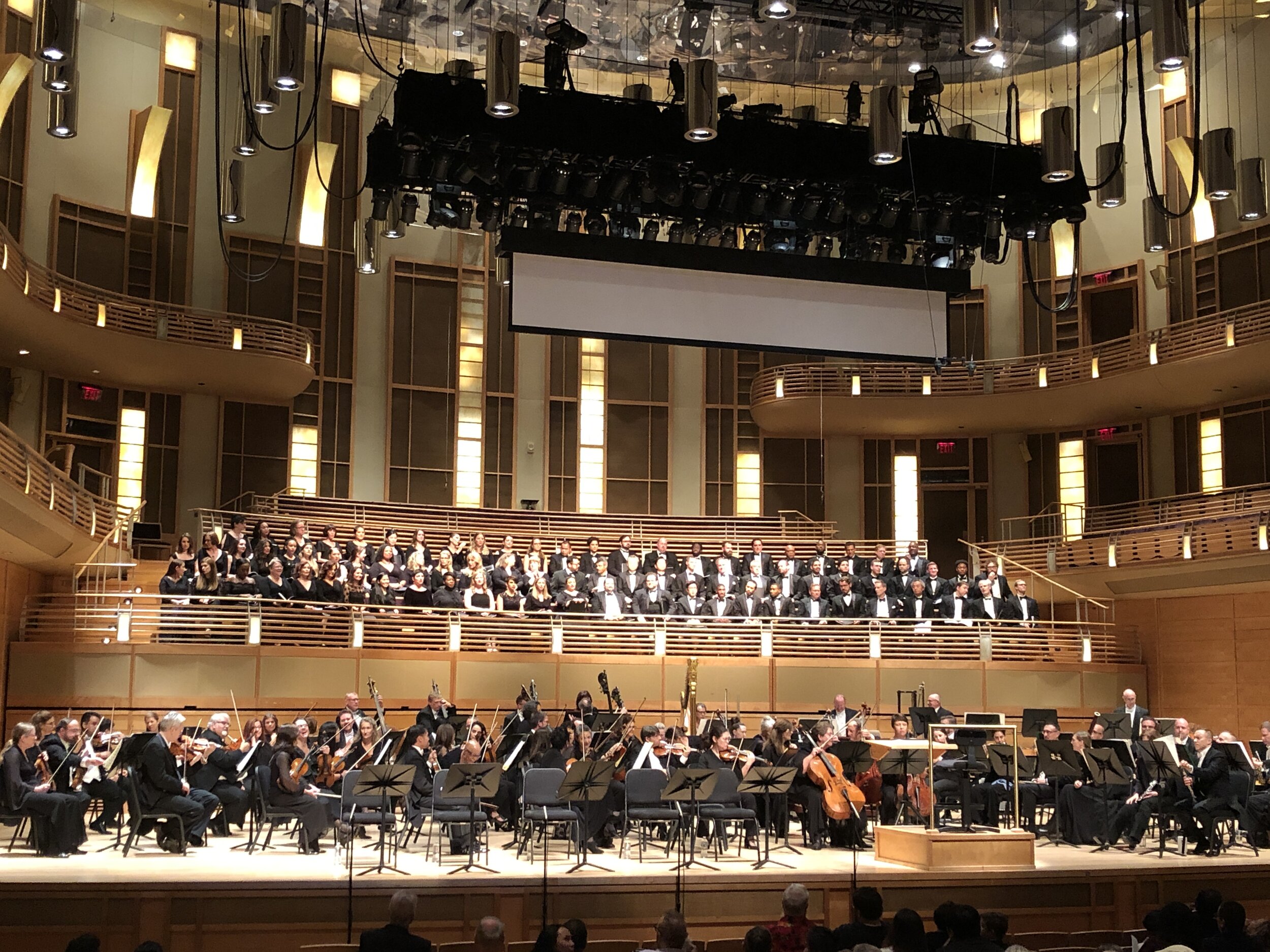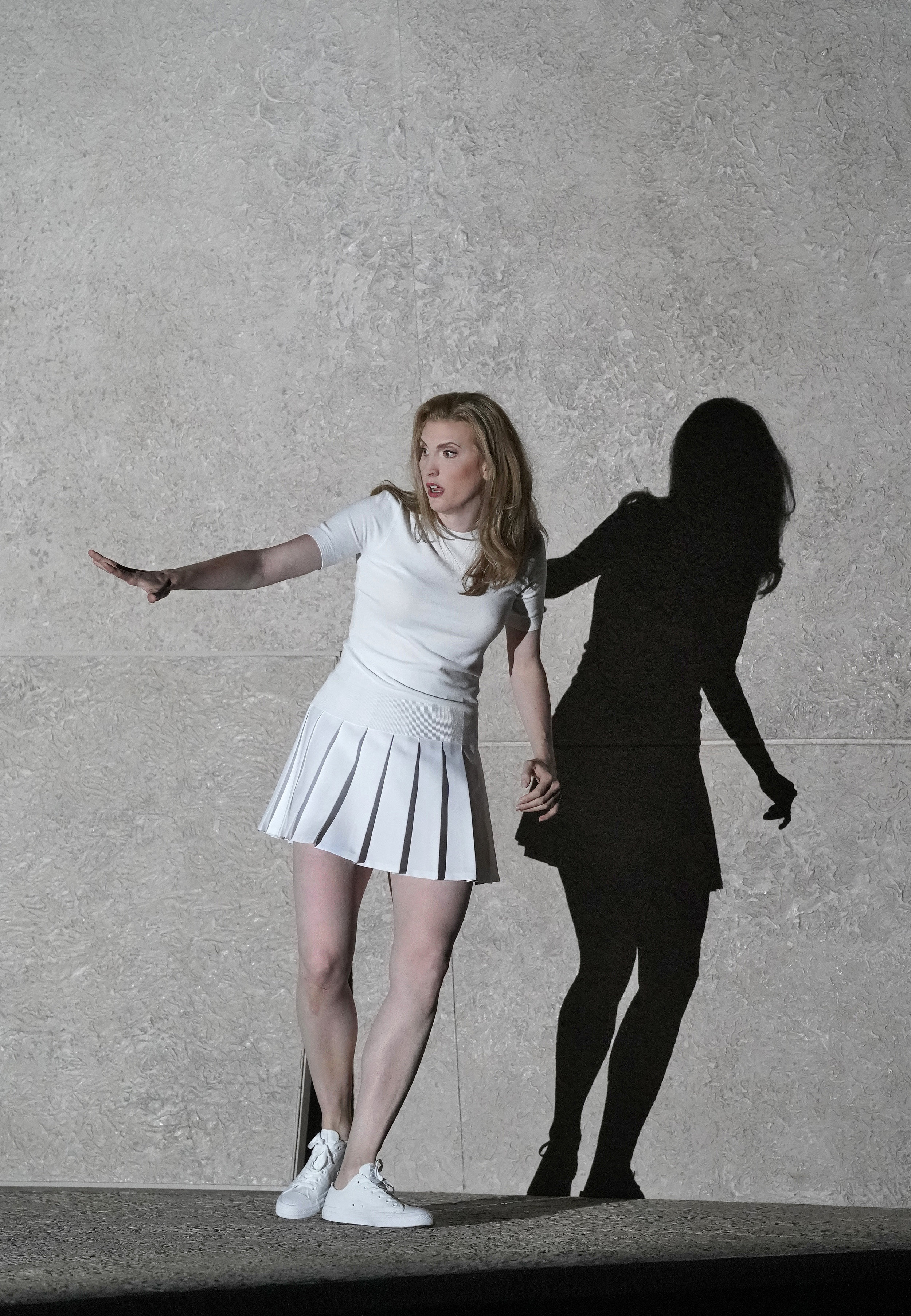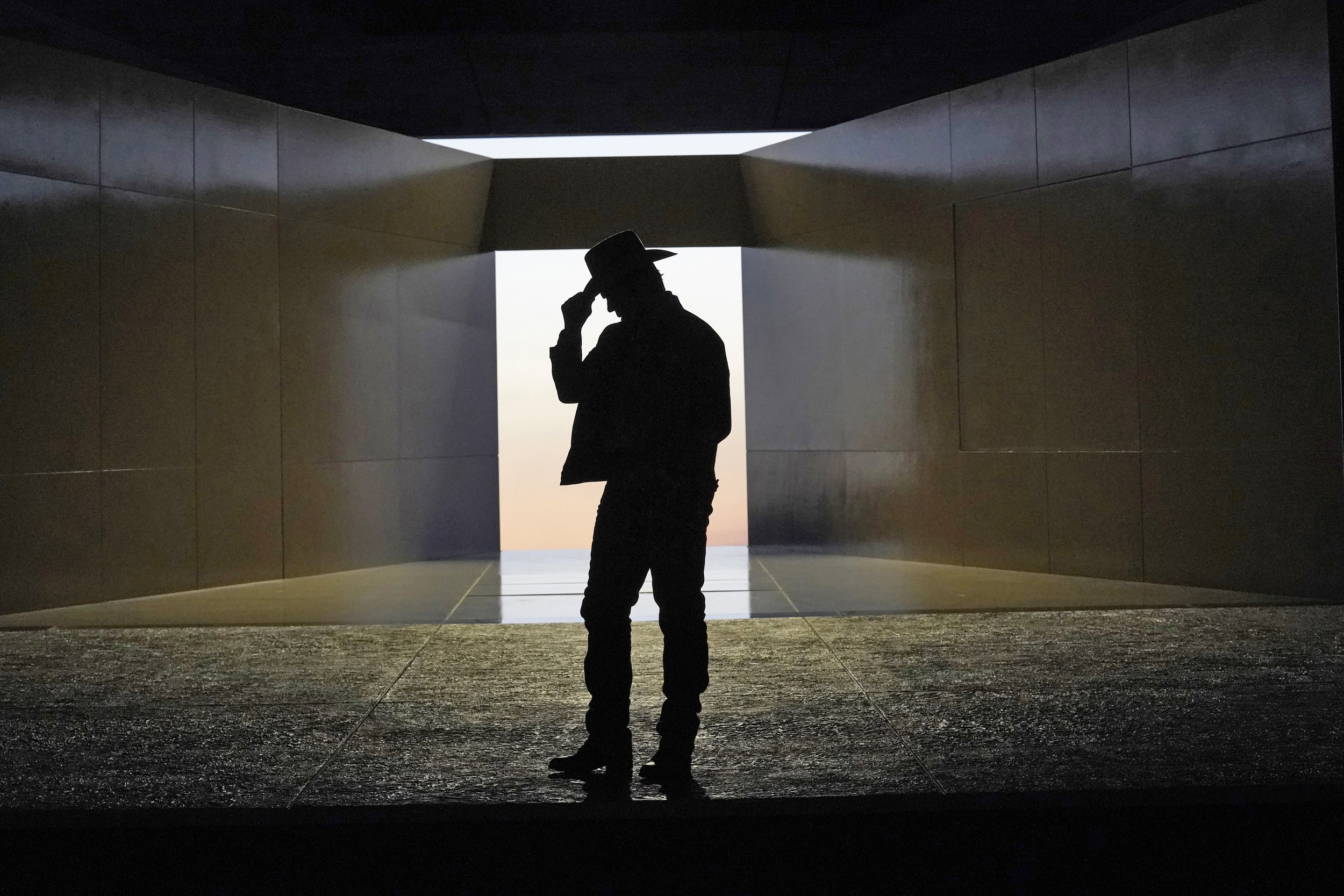My wife schedules our vacations. The deal we had was to spend Christmas in Paris to attend the opera for me (see my previous blog report) and to spend New Year’s Eve in Lyon to visit France’s gastronomic capital for my wife. My wife noticed Opéra de Lyon was performing on New Year’s Day and gave me another treat, opera in Lyon. We were concerned that the ongoing strike in France might imperil our Lyon plans as it did our plans in Paris, but to our delight, we arrived on time and the show went on.
King Carrot (Christophe Mortagne) and his rooted entourage appear at the royal court. 2019 Photo by Blandine Soulage; courtesy of Opéra Lyon.
(Disclaimer: Parents, if your children already have trouble eating their vegetables, do not take them to this opera.)
The opera being performed on New Year’s Day was the last performance of Le Roi Carotte (1872, The Carrot King) by French composer Jacques Offenbach. The opera was sung in French and the supertitles were only available in French; supertitles were not projected during the spoken dialog. I had read a synopsis and background on the opera before attending, but do not speak French. Despite my limitation, I thoroughly enjoyed the opera, as did my wife and son, and it is ironic that I had just reported on watching opera the old-fashioned way, without the benefit of supertitles in English.
To be honest, not only had I not seen this opera before, but I had not even heard of it before my wife made me aware of the Lyon production; not a lot has been written about this opera of Offenbach’s, at least in English. Like so many worthwhile operas buried in the past, it receives little attention while La Traviata and Le Marriage de Figaro get performed daily. I understand an opera company has got to make a living, but I will point out the performance I attended was a sellout. I welcome more rediscovered works, as apparently do others.
Cunégonde (Catherine Trottman) and Fridolin (Yann Beuron) meet and like each other. 2019 Photo by Blandine Soulage; courtesy of Opéra Lyon.
The opera has an interesting history, beginning with its composer. Offenbach has one opera in the modern repertoire that gets performed regularly, The Tales of Hoffman, his only serious opera. He wrote over a hundred operas and operettas, best known in his day for his gay, light-hearted, often satirical operettas. I suppose Le Roi Carotte could be considered an operetta except that it runs close to three hours long. He is credited with being one of the originators of the operetta, a form he used to reflect the gaiety of life in Paris during the second half of the nineteenth century, a period known as La Belle Epoque, a golden age in Europe. He wrote the popular musical number known as the Can Can, which appears in another comic opera of his, Orpheus in the Underworld. The sell-out for the performance may have been because it was on a holiday, or perhaps.….the audience was responding to a need to be reminded that life can be gay, to remove ourselves for a couple of hours from our own troubled times.
Le Roi Carotte was a hit in its initial run in 1872, but fell out of favor, presumably due to the huge cast and costume and set changes required, making its performance an expensive proposition, and perhaps due to the bite of its satire directed at the political factions of its day. The libretto was written by Victorien Sardu, after a tale by E. T. A. Hoffman; you might remember Sardu as the librettist for Puccini’s Tosca. The Lyon production was a repeat of its December 2015 revival of the opera that featured a new staging and costumes by Director Laurent Pelly and an adaptation and dialog changes by Agathe Mélinand. The 2015 production was a huge success and was named “Best Rediscovered Work” at the 2016 International Opera Awards; Le Roi Carotte had not previously been performed since the composer’s lifetime.
Under Coloquinte’s spell, the court ladies are charmed by King Carrot (Christophe Mortagne). 2019 Photo by Blandine Soulage; courtesy of Opéra Lyon.
This is a plot of many characters, thirteen named players plus a wide variety of townspeople, vegetables, and insects. I’m guessing between fifty to one hundred performers were on stage at some point during the performance. Except for the veiled satirical digs at various political groups, the plot is nonsensical. I will only offer comments on the plot since a straightforward description is beyond my abilities. Young King Fridolin is attempting to save his country’s finances after almost bankrupting it with his youthful spending ways. To restore some funds to the state’s coffers, he plans both to sell the castle’s armor to genie Robin-Luron and to marry Princess Cunégonde for her wealth. Fridolin and Cunégonde meet, each traveling incognito, and they like each other; the wedding is assured. However, spirits appearing as vegetables are growing until they sprout arms and legs and faces. They are led by the evil sorcerer, King Carrot. Witch Coloquinte, to get revenge, puts the townspeople under a spell making them follow King Carrot. Cunégonde is quite taken with the new King. Fridolin, Robin-Luron, and Rosee du savoir (who loves Fridolin and has escaped imprisonment by Coloquinte) seek out help from a magician, who directs them to travel to Pompeii to obtain a magic ring, which they manage to do. However, on return, Coloquinte causes Fridolin to lose the ring and be attacked by hordes of insects. Fridolin escapes, and the people rise up against the Carrot King who is managing the economy badly and restore Fridolin to the throne. Fridolin and Rosee du savior live happily ever after, we presume. If I went into detail, it wouldn’t make any more sense. Go with the flow.
Because the plot is nonsensical, staging is the real king for this opera. Director Pelly moves the action at a fast clip and adds a myriad of marvelous costumes to engage the eye and numerous sight gags, the best of which are anachronistic, such as the princess being accompanied by secret service agents dressed in black suits and sunglasses. The visit to Pompeii was totally a hoot. Unfortunately, I could not appreciate the humor in Ms. Mélinand’s new dialogs since I do not speak French; hopefully, Le Roi Carotte will make it to the U.S., and I can make use of supertitles in English. But suffice it is to say that there was a delightful surprise at every turn. With its large-scale variety and most of the performers clearly playing to the audience, there is a circus-like comedic feel to this production. The staging was superb, and it is a critical element of this particular opera.
The citizens of Pompei protect the magic ring. 2019 Photo by Blandine Soulage; courtesy of Opéra Lyon.
Offenbach’s music has one significant flaw: it is likeable. Critics and musicologists in the twentieth century decided that likeable music was frivolous and placed Offenbach’s comedies on a lower shelf. Somehow I seem to enjoy both Beethoven and Offenbach. I greatly enjoyed the music and its many pleasing melodies. Conductor Adrien Perruchon and the orchestra entertained us with Offenbach’s often bouncy music. Le Roi Carotte is worthy of its reemergence just to enjoy its music. Combine that with a circus-like production and it was great holiday fun.
The cast was excellent overall. Fridolin was played by tenor Yann Beuron, a pleasant, consistent tenor who provided the focal point for the opera. Excellent mezzo-soprano Julie Boulianne, in a pants role, gave us a compelling Robin-Luron. Catherine Trottman who has a pretty soprano voice was also charming and funny as Cungégonde. My personal favorite in this cast was soprano Chloé Briot as Rosée du soir; her voice possesses an emotional quality in its timbre that is very engaging; her opening aria won me over completely. Tenor Christophe Mortagne played the self-absorbed King Carrot so convincingly that he drew a few boos at the end, for his character, not him. Actress Lydie Pruvot gave us a vengeful Coloquinte. And there were quite a few of other singers who had their moments that contributed to the success of the production, too many to go on about. I will mention one more which is a group; the outstanding chorus was a major player in Offenbach’s music and the performance; kudos to chorus master Roberto Balistreri. Many of the singers also sang in the 2015 production, including Beuron, Boulianne, Briot, and Mortagne.
The citizens once rise up against King Carrot and throw their support to Fridolin (Yann Beuron). 2015 Photo by Bertrand Slofleth; courtesy of Opéra Lyon.
Satire can be found in Le Roi Carotte (The Carot King), Jacques Offenbach’s opera buffa involving vegetables (maybe even more so if you speak French), but I think that for most of the audience it is simply great music supporting a riotous fairy tale story presented with inventive and consistently surprising staging. The entertainment value of the Opéra Lyon production was very high, and though one can find parallels in today’s world politics if one wishes to look, I don’t advise looking too deeply. Let it be enough that there are good guys and bad guys, and in the end, the good guys and the audience wins, a treat very appropriate for the holiday period, and perhaps even needed in today’s times.
(Addendum to Disclaimer: My disclaimer above is totally in jest. There were many children in the audience and there have been no reports of children with increased vegetable avoidance.)
The Fan Experience: Opéra de Lyon’s next production will be Tosca which begins January 20. There were eight performances of Le Roi Carotte ending on New Year’s Day. One special treat of the holiday performance was an encore song by the entire troupe and a burst of silver and red streamers and confetti at the close. There were no free programs for the performance, but there was available for purchase a souvenir program in French that included relevant essays about the opera and its period of history.
One feature that was different with the French audience was that the applause at the end was rhythmic. Although only a few individuals along the sides stood at the end, the rhythmic clapping was thunderous and lasted for several minutes. Le Roi Carotte was again a hit.
The Lyon National Opera venue is among stately buildings in Place de la Comedie between the Rhône and Saône rivers with an adjacent subway stop. The opera house is moderate in size with a seating capacity of 1,100, an ideal size for opera in my opinion. The building has an impressive façade and is topped by a large cylindrical glass roof that is lit up red on performance nights. The interior of the auditorium is dressed in black and has five U-shaped balconies stacked atop one another. The bar area has magnificent paintings on the sides and ceiling. The seats are wooden, and I noticed cushions are available for rental. There are lots of staffers available to help you find your way around. Photos by author:







